By InvestMacro
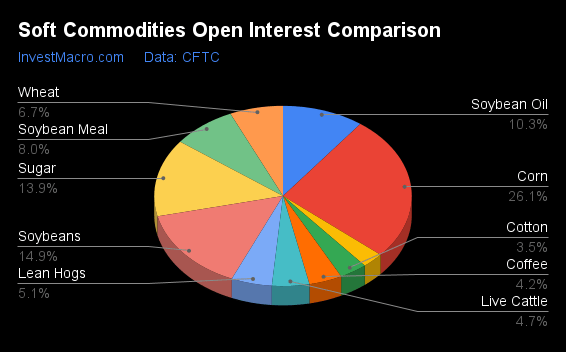
Here are the latest charts and statistics for the Commitment of Traders (COT) reports data published by the Commodities Futures Trading Commission (CFTC).
The latest COT data is updated through Tuesday April 16th and shows a quick view of how large traders (for-profit speculators and commercial entities) were positioned in the futures markets.
Weekly Speculator Changes led by Soybean Meal & Lean Hogs

The COT soft commodities markets speculator bets were overall lower this week as just three out of the eleven softs markets we cover had higher positioning while the other eight markets had lower speculator contracts.
Leading the gains for the softs markets was Soybean Meal (9,230 contracts) with Lean Hogs (4,276 contracts) and Coffee (2,508 contracts) also seeing positive weeks.
The markets with the declines in speculator bets this week were Sugar (-43,130 contracts), Soybean Oil (-23,914 contracts), Cotton (-20,347 contracts), Corn (-14,666 contracts), Soybeans (-13,416 contracts), Wheat (-10,500 contracts), Live Cattle (-5,960 contracts) and with Cocoa (-1,073 contracts) also registering lower bets on the week.
Soft Commodities Net Speculators Leaderboard
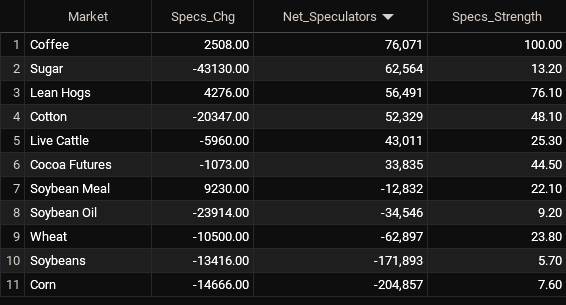
Legend: Weekly Speculators Change | Speculators Current Net Position | Speculators Strength Score compared to last 3-Years (0-100 range)
Strength Scores led by Coffee & Lean Hogs
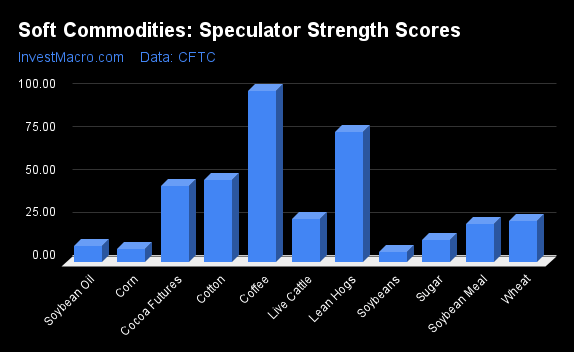
COT Strength Scores (a normalized measure of Speculator positions over a 3-Year range, from 0 to 100 where above 80 is Extreme-Bullish and below 20 is Extreme-Bearish) showed that Coffee (100 percent) and Lean Hogs (76 percent) lead the softs markets this week.
On the downside, Soybeans (6 percent), Corn (8 percent), Soybean Oil (9 percent) and Sugar (13 percent) come in at the lowest strength levels currently and are all in Extreme-Bearish territory (below 20 percent).
Strength Statistics:
Corn (7.6 percent) vs Corn previous week (9.5 percent)
Sugar (13.2 percent) vs Sugar previous week (28.8 percent)
Coffee (100.0 percent) vs Coffee previous week (97.6 percent)
Soybeans (5.7 percent) vs Soybeans previous week (8.7 percent)
Soybean Oil (9.2 percent) vs Soybean Oil previous week (24.5 percent)
Soybean Meal (22.1 percent) vs Soybean Meal previous week (18.4 percent)
Live Cattle (25.3 percent) vs Live Cattle previous week (31.7 percent)
Lean Hogs (76.1 percent) vs Lean Hogs previous week (72.6 percent)
Cotton (48.1 percent) vs Cotton previous week (63.4 percent)
Cocoa (44.5 percent) vs Cocoa previous week (45.6 percent)
Wheat (23.8 percent) vs Wheat previous week (31.1 percent)
Coffee & Soybean Meal top the 6-Week Strength Trends

COT Strength Score Trends (or move index, calculates the 6-week changes in strength scores) showed that Coffee (22 percent) and Soybean Meal (19 percent) lead the past six weeks trends for soft commodities. Lean Hogs (19 percent), Soybean Oil (9 percent) and Soybeans (6 percent) are the next highest positive movers in the latest trends data.
Cotton (-37 percent) leads the downside trend scores currently with Live Cattle (-28 percent), Wheat (-13 percent) and Cocoa (-10 percent) following next with lower trend scores.
Strength Trend Statistics:
Corn (3.2 percent) vs Corn previous week (5.3 percent)
Sugar (-7.0 percent) vs Sugar previous week (0.9 percent)
Coffee (22.0 percent) vs Coffee previous week (21.3 percent)
Soybeans (5.7 percent) vs Soybeans previous week (7.3 percent)
Soybean Oil (9.2 percent) vs Soybean Oil previous week (18.2 percent)
Soybean Meal (19.1 percent) vs Soybean Meal previous week (18.4 percent)
Live Cattle (-27.9 percent) vs Live Cattle previous week (-18.4 percent)
Lean Hogs (18.6 percent) vs Lean Hogs previous week (18.8 percent)
Cotton (-36.7 percent) vs Cotton previous week (-22.3 percent)
Cocoa (-9.7 percent) vs Cocoa previous week (-6.4 percent)
Wheat (-12.6 percent) vs Wheat previous week (-10.7 percent)
Individual Soft Commodities Markets:
CORN Futures:
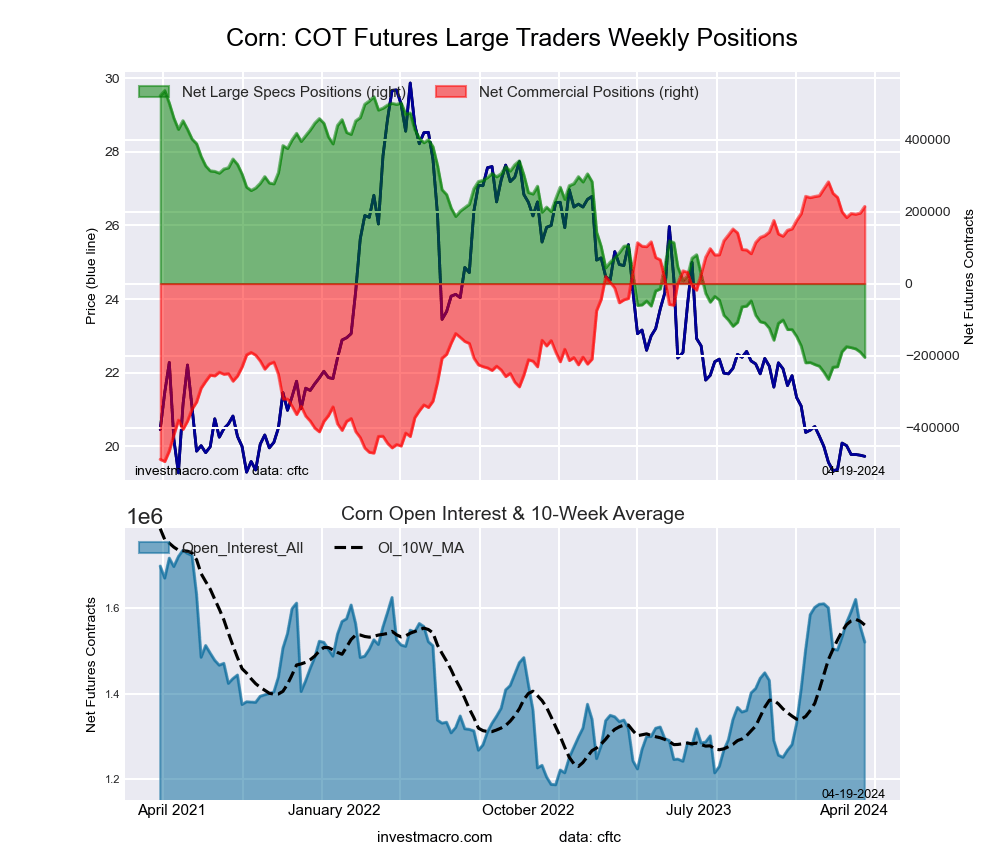 The CORN large speculator standing this week came in at a net position of -204,857 contracts in the data reported through Tuesday. This was a weekly fall of -14,666 contracts from the previous week which had a total of -190,191 net contracts.
The CORN large speculator standing this week came in at a net position of -204,857 contracts in the data reported through Tuesday. This was a weekly fall of -14,666 contracts from the previous week which had a total of -190,191 net contracts.
This week’s current strength score (the trader positioning range over the past three years, measured from 0 to 100) shows the speculators are currently Bearish-Extreme with a score of 7.6 percent. The commercials are Bullish-Extreme with a score of 91.2 percent and the small traders (not shown in chart) are Bullish-Extreme with a score of 95.2 percent.
Price Trend-Following Model: Downtrend
Our weekly trend-following model classifies the current market price position as: Downtrend. The current action for the model is considered to be: Hold – Maintain Short Position.
| CORN Futures Statistics | SPECULATORS | COMMERCIALS | SMALL TRADERS |
| – Percent of Open Interest Longs: | 18.3 | 45.3 | 10.3 |
| – Percent of Open Interest Shorts: | 31.8 | 31.2 | 10.9 |
| – Net Position: | -204,857 | 214,170 | -9,313 |
| – Gross Longs: | 278,571 | 688,963 | 157,042 |
| – Gross Shorts: | 483,428 | 474,793 | 166,355 |
| – Long to Short Ratio: | 0.6 to 1 | 1.5 to 1 | 0.9 to 1 |
| NET POSITION TREND: | | | |
| – Strength Index Score (3 Year Range Pct): | 7.6 | 91.2 | 95.2 |
| – Strength Index Reading (3 Year Range): | Bearish-Extreme | Bullish-Extreme | Bullish-Extreme |
| NET POSITION MOVEMENT INDEX: | | | |
| – 6-Week Change in Strength Index: | 3.2 | -3.3 | -1.0 |
SUGAR Futures:
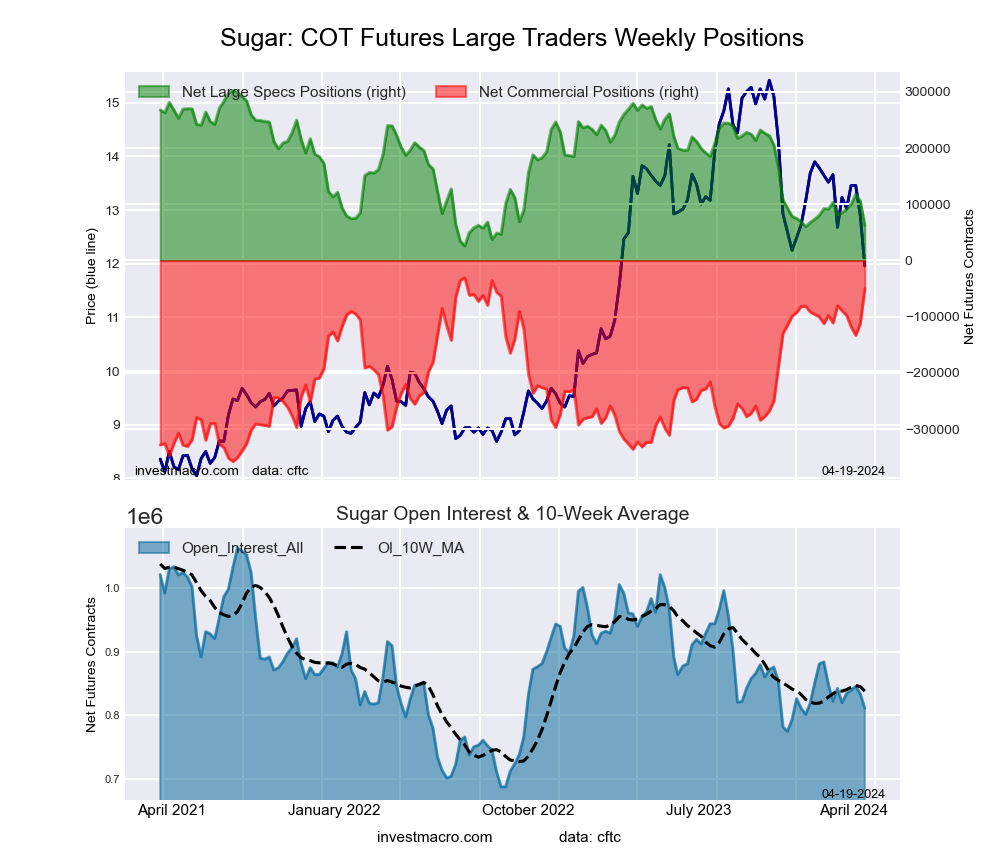 The SUGAR large speculator standing this week came in at a net position of 62,564 contracts in the data reported through Tuesday. This was a weekly decrease of -43,130 contracts from the previous week which had a total of 105,694 net contracts.
The SUGAR large speculator standing this week came in at a net position of 62,564 contracts in the data reported through Tuesday. This was a weekly decrease of -43,130 contracts from the previous week which had a total of 105,694 net contracts.
This week’s current strength score (the trader positioning range over the past three years, measured from 0 to 100) shows the speculators are currently Bearish-Extreme with a score of 13.2 percent. The commercials are Bullish-Extreme with a score of 94.0 percent and the small traders (not shown in chart) are Bearish-Extreme with a score of 0.0 percent.
Price Trend-Following Model: Strong Downtrend
Our weekly trend-following model classifies the current market price position as: Strong Downtrend. The current action for the model is considered to be: Hold – Maintain Short Position.
| SUGAR Futures Statistics | SPECULATORS | COMMERCIALS | SMALL TRADERS |
| – Percent of Open Interest Longs: | 22.9 | 55.3 | 8.7 |
| – Percent of Open Interest Shorts: | 15.2 | 61.5 | 10.2 |
| – Net Position: | 62,564 | -50,279 | -12,285 |
| – Gross Longs: | 186,059 | 448,732 | 70,228 |
| – Gross Shorts: | 123,495 | 499,011 | 82,513 |
| – Long to Short Ratio: | 1.5 to 1 | 0.9 to 1 | 0.9 to 1 |
| NET POSITION TREND: | | | |
| – Strength Index Score (3 Year Range Pct): | 13.2 | 94.0 | 0.0 |
| – Strength Index Reading (3 Year Range): | Bearish-Extreme | Bullish-Extreme | Bearish-Extreme |
| NET POSITION MOVEMENT INDEX: | | | |
| – 6-Week Change in Strength Index: | -7.0 | 9.3 | -14.2 |
COFFEE Futures:
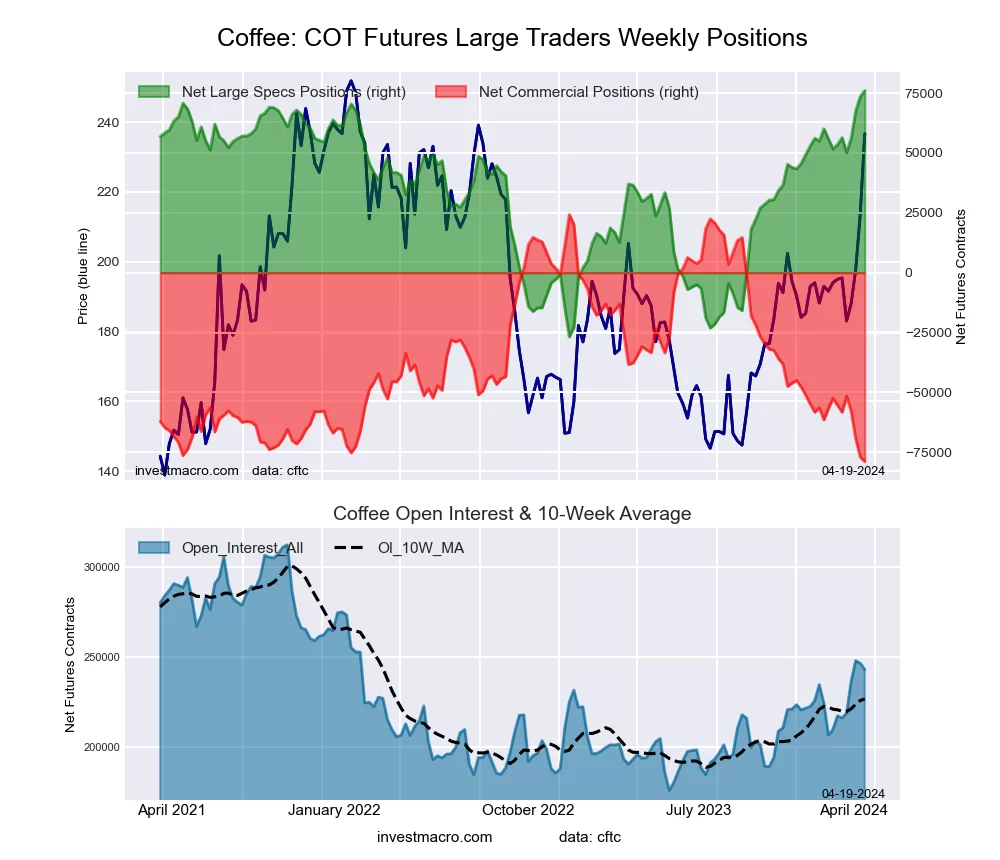 The COFFEE large speculator standing this week came in at a net position of 76,071 contracts in the data reported through Tuesday. This was a weekly gain of 2,508 contracts from the previous week which had a total of 73,563 net contracts.
The COFFEE large speculator standing this week came in at a net position of 76,071 contracts in the data reported through Tuesday. This was a weekly gain of 2,508 contracts from the previous week which had a total of 73,563 net contracts.
This week’s current strength score (the trader positioning range over the past three years, measured from 0 to 100) shows the speculators are currently Bullish-Extreme with a score of 100.0 percent. The commercials are Bearish-Extreme with a score of 0.0 percent and the small traders (not shown in chart) are Bullish with a score of 51.5 percent.
Price Trend-Following Model: Strong Uptrend
Our weekly trend-following model classifies the current market price position as: Strong Uptrend. The current action for the model is considered to be: Hold – Maintain Long Position.
| COFFEE Futures Statistics | SPECULATORS | COMMERCIALS | SMALL TRADERS |
| – Percent of Open Interest Longs: | 40.5 | 35.6 | 3.7 |
| – Percent of Open Interest Shorts: | 9.1 | 68.1 | 2.5 |
| – Net Position: | 76,071 | -78,835 | 2,764 |
| – Gross Longs: | 98,292 | 86,582 | 8,934 |
| – Gross Shorts: | 22,221 | 165,417 | 6,170 |
| – Long to Short Ratio: | 4.4 to 1 | 0.5 to 1 | 1.4 to 1 |
| NET POSITION TREND: | | | |
| – Strength Index Score (3 Year Range Pct): | 100.0 | 0.0 | 51.5 |
| – Strength Index Reading (3 Year Range): | Bullish-Extreme | Bearish-Extreme | Bullish |
| NET POSITION MOVEMENT INDEX: | | | |
| – 6-Week Change in Strength Index: | 22.0 | -22.8 | 11.9 |
SOYBEANS Futures:
 The SOYBEANS large speculator standing this week came in at a net position of -171,893 contracts in the data reported through Tuesday. This was a weekly fall of -13,416 contracts from the previous week which had a total of -158,477 net contracts.
The SOYBEANS large speculator standing this week came in at a net position of -171,893 contracts in the data reported through Tuesday. This was a weekly fall of -13,416 contracts from the previous week which had a total of -158,477 net contracts.
This week’s current strength score (the trader positioning range over the past three years, measured from 0 to 100) shows the speculators are currently Bearish-Extreme with a score of 5.7 percent. The commercials are Bullish-Extreme with a score of 94.0 percent and the small traders (not shown in chart) are Bullish-Extreme with a score of 86.2 percent.
Price Trend-Following Model: Downtrend
Our weekly trend-following model classifies the current market price position as: Downtrend. The current action for the model is considered to be: Hold – Maintain Short Position.
| SOYBEANS Futures Statistics | SPECULATORS | COMMERCIALS | SMALL TRADERS |
| – Percent of Open Interest Longs: | 10.9 | 58.0 | 6.6 |
| – Percent of Open Interest Shorts: | 30.7 | 37.3 | 7.5 |
| – Net Position: | -171,893 | 179,718 | -7,825 |
| – Gross Longs: | 94,418 | 503,032 | 56,980 |
| – Gross Shorts: | 266,311 | 323,314 | 64,805 |
| – Long to Short Ratio: | 0.4 to 1 | 1.6 to 1 | 0.9 to 1 |
| NET POSITION TREND: | | | |
| – Strength Index Score (3 Year Range Pct): | 5.7 | 94.0 | 86.2 |
| – Strength Index Reading (3 Year Range): | Bearish-Extreme | Bullish-Extreme | Bullish-Extreme |
| NET POSITION MOVEMENT INDEX: | | | |
| – 6-Week Change in Strength Index: | 5.7 | -6.0 | 5.4 |
SOYBEAN OIL Futures:
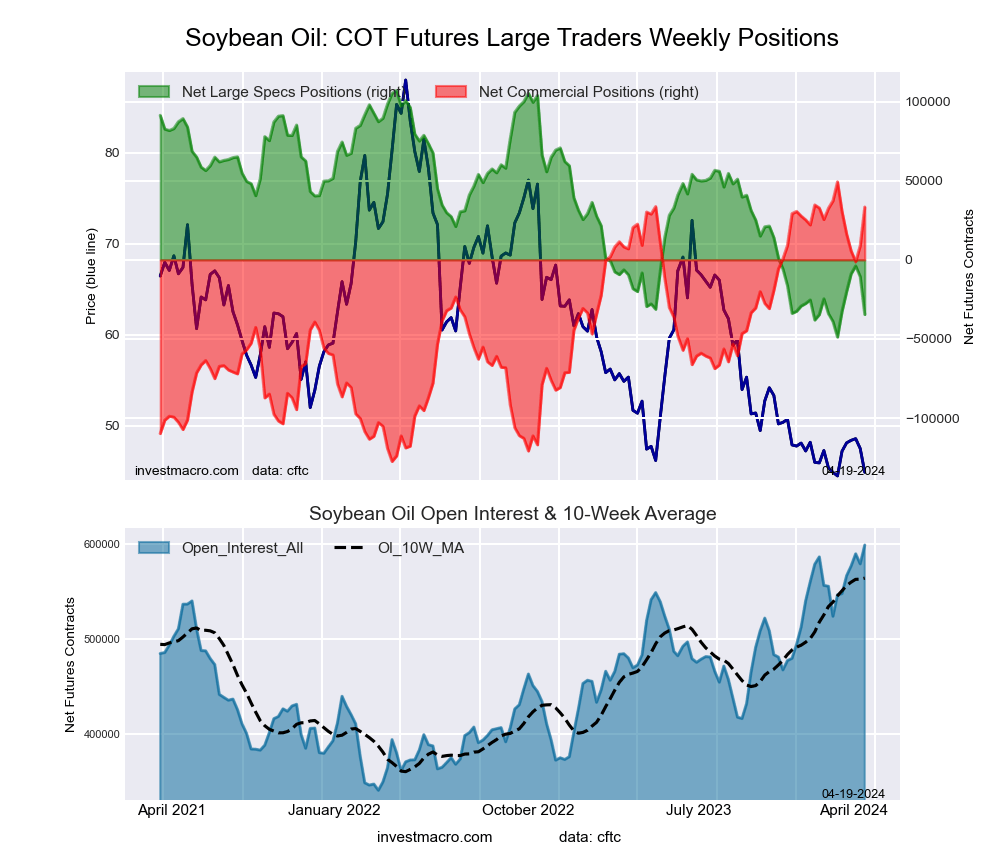 The SOYBEAN OIL large speculator standing this week came in at a net position of -34,546 contracts in the data reported through Tuesday. This was a weekly lowering of -23,914 contracts from the previous week which had a total of -10,632 net contracts.
The SOYBEAN OIL large speculator standing this week came in at a net position of -34,546 contracts in the data reported through Tuesday. This was a weekly lowering of -23,914 contracts from the previous week which had a total of -10,632 net contracts.
This week’s current strength score (the trader positioning range over the past three years, measured from 0 to 100) shows the speculators are currently Bearish-Extreme with a score of 9.2 percent. The commercials are Bullish-Extreme with a score of 91.0 percent and the small traders (not shown in chart) are Bearish-Extreme with a score of 18.8 percent.
Price Trend-Following Model: Strong Downtrend
Our weekly trend-following model classifies the current market price position as: Strong Downtrend. The current action for the model is considered to be: Hold – Maintain Short Position.
| SOYBEAN OIL Futures Statistics | SPECULATORS | COMMERCIALS | SMALL TRADERS |
| – Percent of Open Interest Longs: | 19.4 | 50.2 | 4.9 |
| – Percent of Open Interest Shorts: | 25.2 | 44.7 | 4.7 |
| – Net Position: | -34,546 | 33,327 | 1,219 |
| – Gross Longs: | 116,442 | 300,903 | 29,257 |
| – Gross Shorts: | 150,988 | 267,576 | 28,038 |
| – Long to Short Ratio: | 0.8 to 1 | 1.1 to 1 | 1.0 to 1 |
| NET POSITION TREND: | | | |
| – Strength Index Score (3 Year Range Pct): | 9.2 | 91.0 | 18.8 |
| – Strength Index Reading (3 Year Range): | Bearish-Extreme | Bullish-Extreme | Bearish-Extreme |
| NET POSITION MOVEMENT INDEX: | | | |
| – 6-Week Change in Strength Index: | 9.2 | -9.0 | 6.5 |
SOYBEAN MEAL Futures:
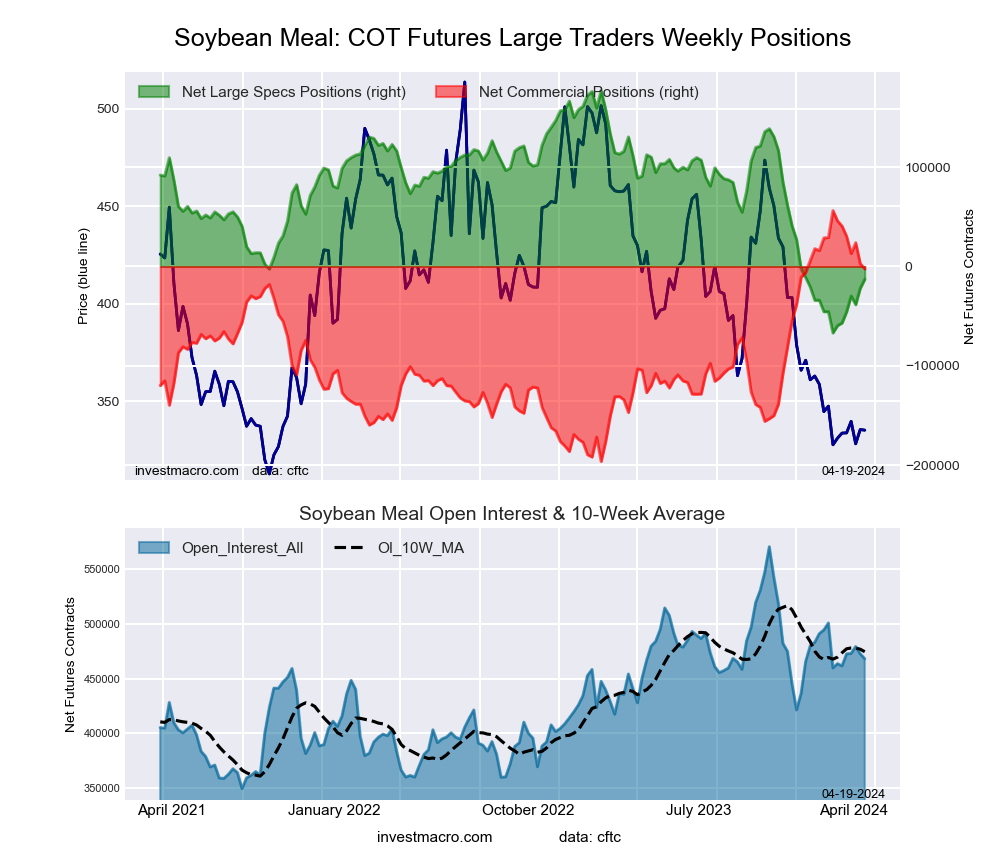 The SOYBEAN MEAL large speculator standing this week came in at a net position of -12,832 contracts in the data reported through Tuesday. This was a weekly rise of 9,230 contracts from the previous week which had a total of -22,062 net contracts.
The SOYBEAN MEAL large speculator standing this week came in at a net position of -12,832 contracts in the data reported through Tuesday. This was a weekly rise of 9,230 contracts from the previous week which had a total of -22,062 net contracts.
This week’s current strength score (the trader positioning range over the past three years, measured from 0 to 100) shows the speculators are currently Bearish with a score of 22.1 percent. The commercials are Bullish with a score of 76.8 percent and the small traders (not shown in chart) are Bearish with a score of 23.9 percent.
Price Trend-Following Model: Downtrend
Our weekly trend-following model classifies the current market price position as: Downtrend. The current action for the model is considered to be: Hold – Maintain Short Position.
| SOYBEAN MEAL Futures Statistics | SPECULATORS | COMMERCIALS | SMALL TRADERS |
| – Percent of Open Interest Longs: | 21.8 | 47.8 | 10.0 |
| – Percent of Open Interest Shorts: | 24.6 | 48.3 | 6.8 |
| – Net Position: | -12,832 | -2,352 | 15,184 |
| – Gross Longs: | 102,248 | 223,843 | 46,819 |
| – Gross Shorts: | 115,080 | 226,195 | 31,635 |
| – Long to Short Ratio: | 0.9 to 1 | 1.0 to 1 | 1.5 to 1 |
| NET POSITION TREND: | | | |
| – Strength Index Score (3 Year Range Pct): | 22.1 | 76.8 | 23.9 |
| – Strength Index Reading (3 Year Range): | Bearish | Bullish | Bearish |
| NET POSITION MOVEMENT INDEX: | | | |
| – 6-Week Change in Strength Index: | 19.1 | -19.1 | 7.0 |
LIVE CATTLE Futures:
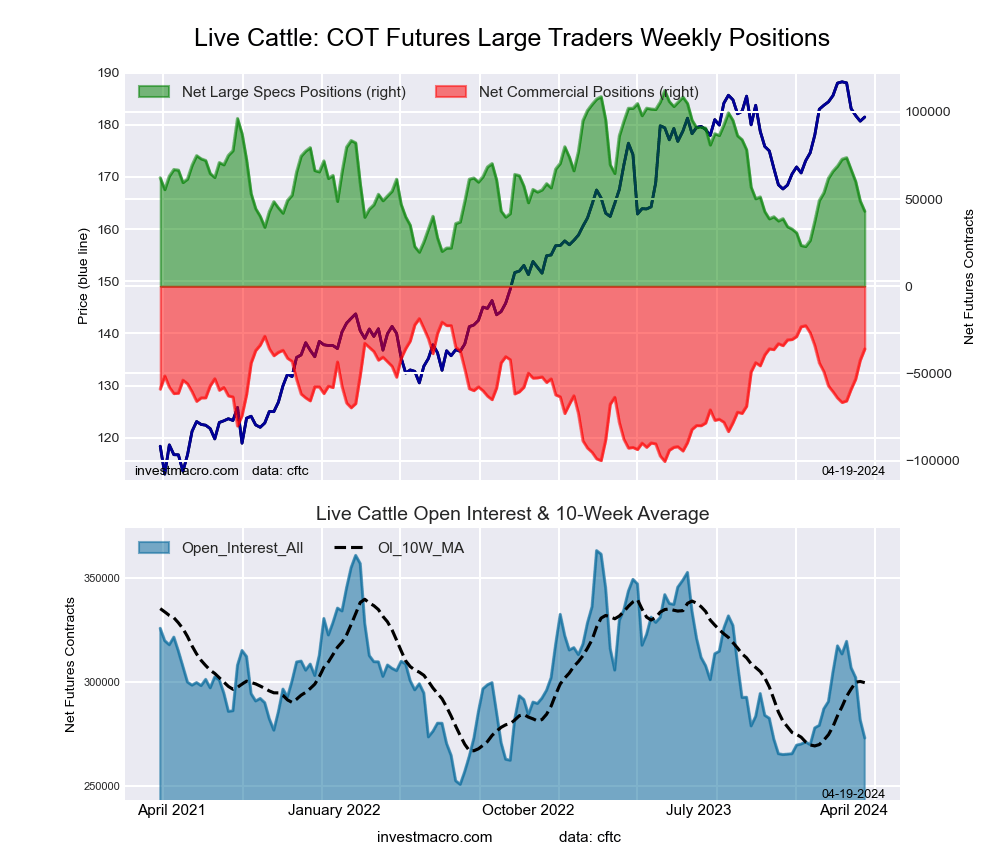 The LIVE CATTLE large speculator standing this week came in at a net position of 43,011 contracts in the data reported through Tuesday. This was a weekly fall of -5,960 contracts from the previous week which had a total of 48,971 net contracts.
The LIVE CATTLE large speculator standing this week came in at a net position of 43,011 contracts in the data reported through Tuesday. This was a weekly fall of -5,960 contracts from the previous week which had a total of 48,971 net contracts.
This week’s current strength score (the trader positioning range over the past three years, measured from 0 to 100) shows the speculators are currently Bearish with a score of 25.3 percent. The commercials are Bullish with a score of 78.7 percent and the small traders (not shown in chart) are Bullish with a score of 52.2 percent.
Price Trend-Following Model: Uptrend
Our weekly trend-following model classifies the current market price position as: Uptrend. The current action for the model is considered to be: Hold – Maintain Long Position.
| LIVE CATTLE Futures Statistics | SPECULATORS | COMMERCIALS | SMALL TRADERS |
| – Percent of Open Interest Longs: | 35.0 | 37.4 | 9.9 |
| – Percent of Open Interest Shorts: | 19.2 | 50.6 | 12.4 |
| – Net Position: | 43,011 | -35,975 | -7,036 |
| – Gross Longs: | 95,527 | 102,062 | 26,945 |
| – Gross Shorts: | 52,516 | 138,037 | 33,981 |
| – Long to Short Ratio: | 1.8 to 1 | 0.7 to 1 | 0.8 to 1 |
| NET POSITION TREND: | | | |
| – Strength Index Score (3 Year Range Pct): | 25.3 | 78.7 | 52.2 |
| – Strength Index Reading (3 Year Range): | Bearish | Bullish | Bullish |
| NET POSITION MOVEMENT INDEX: | | | |
| – 6-Week Change in Strength Index: | -27.9 | 34.3 | -11.8 |
LEAN HOGS Futures:
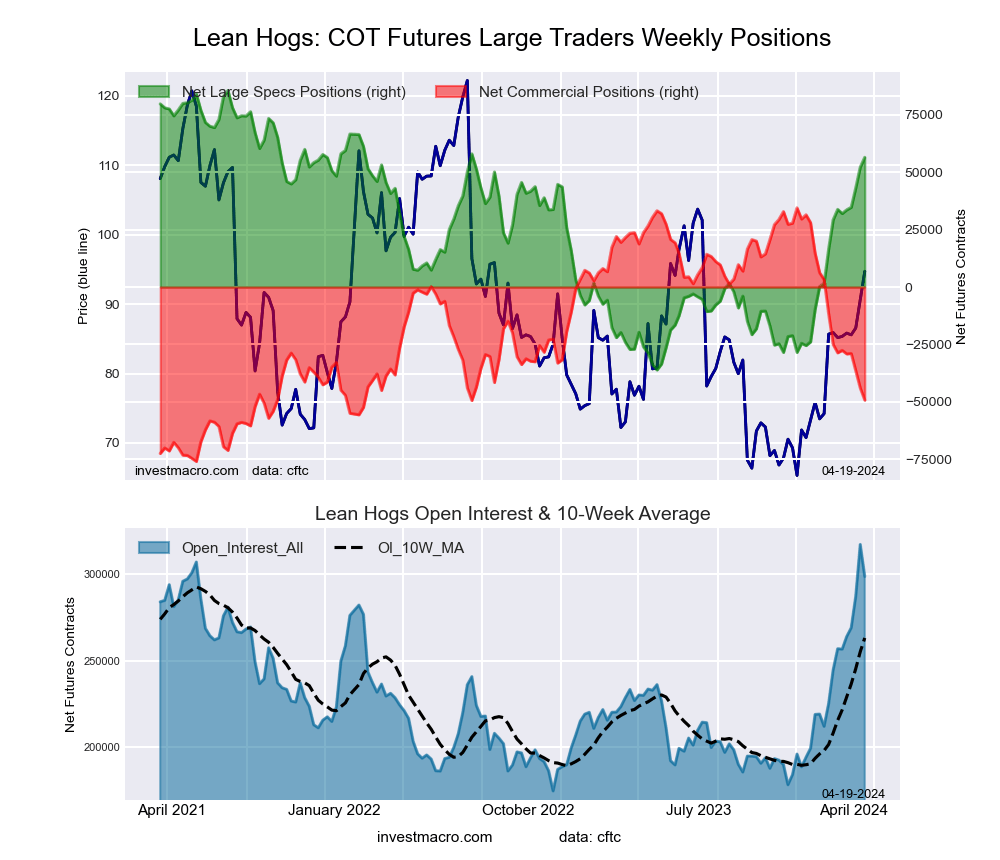 The LEAN HOGS large speculator standing this week came in at a net position of 56,491 contracts in the data reported through Tuesday. This was a weekly boost of 4,276 contracts from the previous week which had a total of 52,215 net contracts.
The LEAN HOGS large speculator standing this week came in at a net position of 56,491 contracts in the data reported through Tuesday. This was a weekly boost of 4,276 contracts from the previous week which had a total of 52,215 net contracts.
This week’s current strength score (the trader positioning range over the past three years, measured from 0 to 100) shows the speculators are currently Bullish with a score of 76.1 percent. The commercials are Bearish with a score of 24.2 percent and the small traders (not shown in chart) are Bullish with a score of 50.9 percent.
Price Trend-Following Model: Strong Uptrend
Our weekly trend-following model classifies the current market price position as: Strong Uptrend. The current action for the model is considered to be: Hold – Maintain Long Position.
| LEAN HOGS Futures Statistics | SPECULATORS | COMMERCIALS | SMALL TRADERS |
| – Percent of Open Interest Longs: | 40.3 | 32.7 | 8.2 |
| – Percent of Open Interest Shorts: | 21.4 | 49.2 | 10.6 |
| – Net Position: | 56,491 | -49,252 | -7,239 |
| – Gross Longs: | 120,485 | 97,818 | 24,451 |
| – Gross Shorts: | 63,994 | 147,070 | 31,690 |
| – Long to Short Ratio: | 1.9 to 1 | 0.7 to 1 | 0.8 to 1 |
| NET POSITION TREND: | | | |
| – Strength Index Score (3 Year Range Pct): | 76.1 | 24.2 | 50.9 |
| – Strength Index Reading (3 Year Range): | Bullish | Bearish | Bullish |
| NET POSITION MOVEMENT INDEX: | | | |
| – 6-Week Change in Strength Index: | 18.6 | -18.7 | -9.2 |
COTTON Futures:
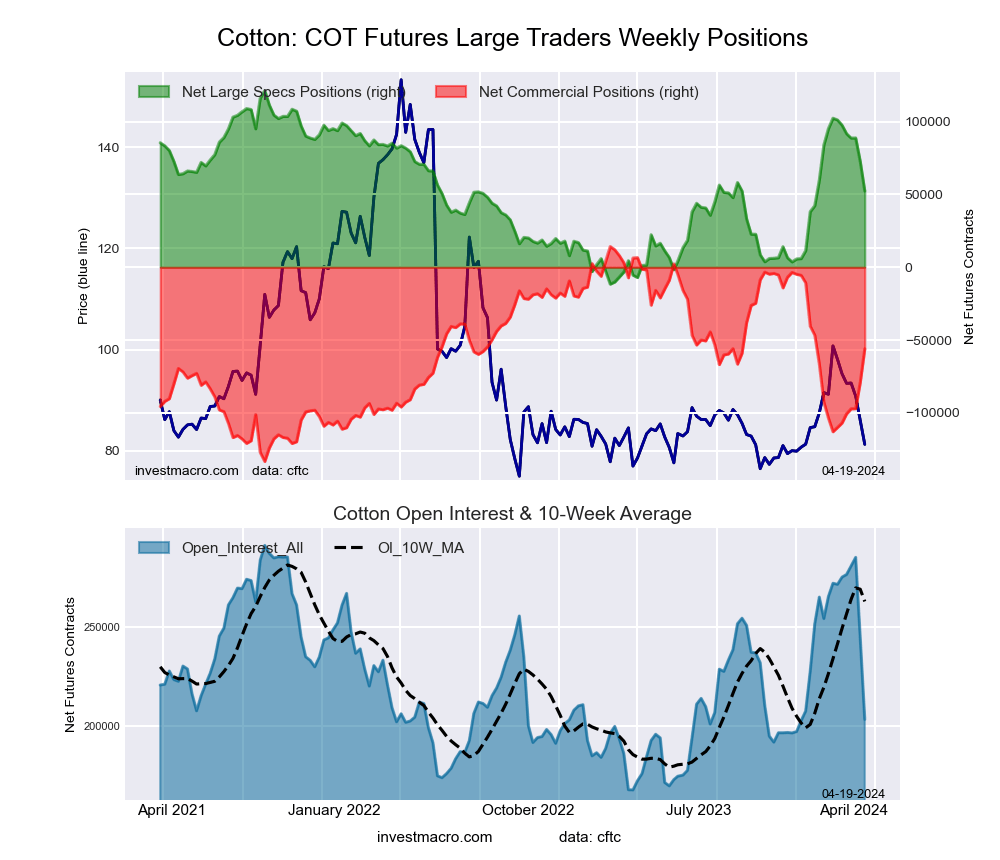 The COTTON large speculator standing this week came in at a net position of 52,329 contracts in the data reported through Tuesday. This was a weekly reduction of -20,347 contracts from the previous week which had a total of 72,676 net contracts.
The COTTON large speculator standing this week came in at a net position of 52,329 contracts in the data reported through Tuesday. This was a weekly reduction of -20,347 contracts from the previous week which had a total of 72,676 net contracts.
This week’s current strength score (the trader positioning range over the past three years, measured from 0 to 100) shows the speculators are currently Bearish with a score of 48.1 percent. The commercials are Bullish with a score of 52.4 percent and the small traders (not shown in chart) are Bearish with a score of 37.9 percent.
Price Trend-Following Model: Weak Uptrend
Our weekly trend-following model classifies the current market price position as: Weak Uptrend. The current action for the model is considered to be: Hold – Maintain Long Position.
| COTTON Futures Statistics | SPECULATORS | COMMERCIALS | SMALL TRADERS |
| – Percent of Open Interest Longs: | 40.8 | 38.0 | 7.1 |
| – Percent of Open Interest Shorts: | 15.1 | 65.4 | 5.4 |
| – Net Position: | 52,329 | -55,943 | 3,614 |
| – Gross Longs: | 83,151 | 77,269 | 14,522 |
| – Gross Shorts: | 30,822 | 133,212 | 10,908 |
| – Long to Short Ratio: | 2.7 to 1 | 0.6 to 1 | 1.3 to 1 |
| NET POSITION TREND: | | | |
| – Strength Index Score (3 Year Range Pct): | 48.1 | 52.4 | 37.9 |
| – Strength Index Reading (3 Year Range): | Bearish | Bullish | Bearish |
| NET POSITION MOVEMENT INDEX: | | | |
| – 6-Week Change in Strength Index: | -36.7 | 36.6 | -31.7 |
COCOA Futures:
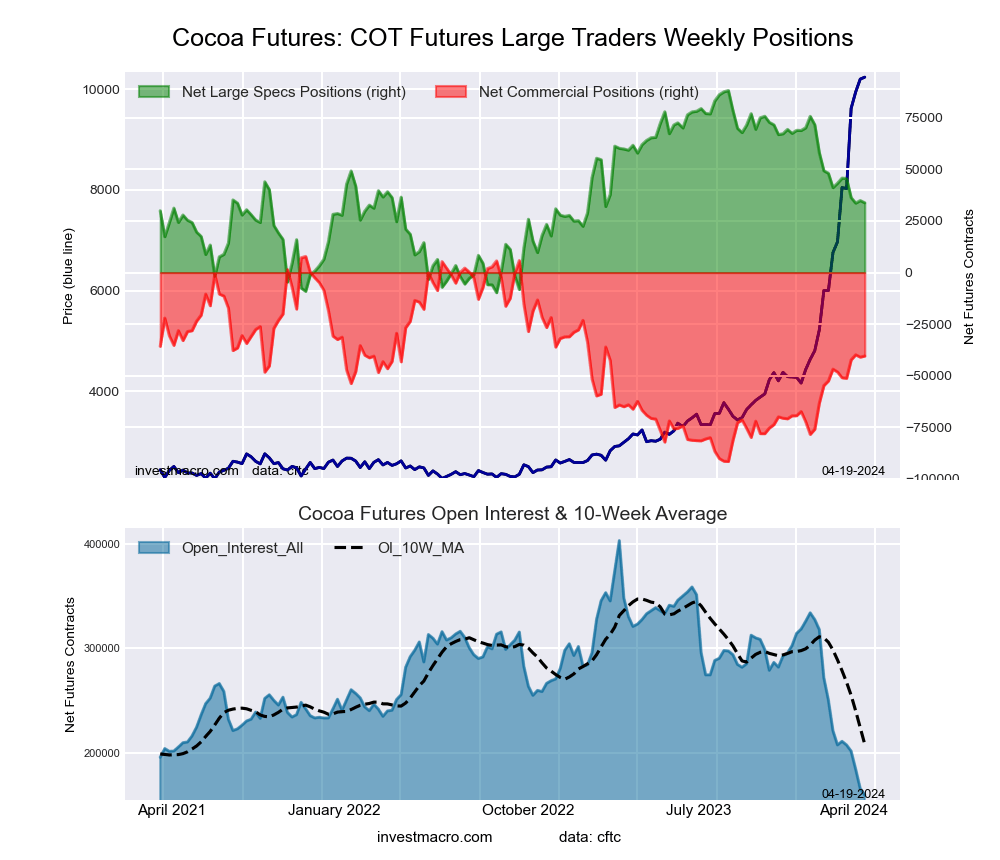 The COCOA large speculator standing this week came in at a net position of 33,835 contracts in the data reported through Tuesday. This was a weekly decline of -1,073 contracts from the previous week which had a total of 34,908 net contracts.
The COCOA large speculator standing this week came in at a net position of 33,835 contracts in the data reported through Tuesday. This was a weekly decline of -1,073 contracts from the previous week which had a total of 34,908 net contracts.
This week’s current strength score (the trader positioning range over the past three years, measured from 0 to 100) shows the speculators are currently Bearish with a score of 44.5 percent. The commercials are Bullish with a score of 51.4 percent and the small traders (not shown in chart) are Bullish with a score of 68.9 percent.
Price Trend-Following Model: Strong Uptrend
Our weekly trend-following model classifies the current market price position as: Strong Uptrend. The current action for the model is considered to be: Hold – Maintain Long Position.
| COCOA Futures Statistics | SPECULATORS | COMMERCIALS | SMALL TRADERS |
| – Percent of Open Interest Longs: | 34.7 | 33.7 | 8.3 |
| – Percent of Open Interest Shorts: | 13.5 | 59.1 | 4.1 |
| – Net Position: | 33,835 | -40,494 | 6,659 |
| – Gross Longs: | 55,310 | 53,725 | 13,258 |
| – Gross Shorts: | 21,475 | 94,219 | 6,599 |
| – Long to Short Ratio: | 2.6 to 1 | 0.6 to 1 | 2.0 to 1 |
| NET POSITION TREND: | | | |
| – Strength Index Score (3 Year Range Pct): | 44.5 | 51.4 | 68.9 |
| – Strength Index Reading (3 Year Range): | Bearish | Bullish | Bullish |
| NET POSITION MOVEMENT INDEX: | | | |
| – 6-Week Change in Strength Index: | -9.7 | 7.8 | 14.8 |
WHEAT Futures:
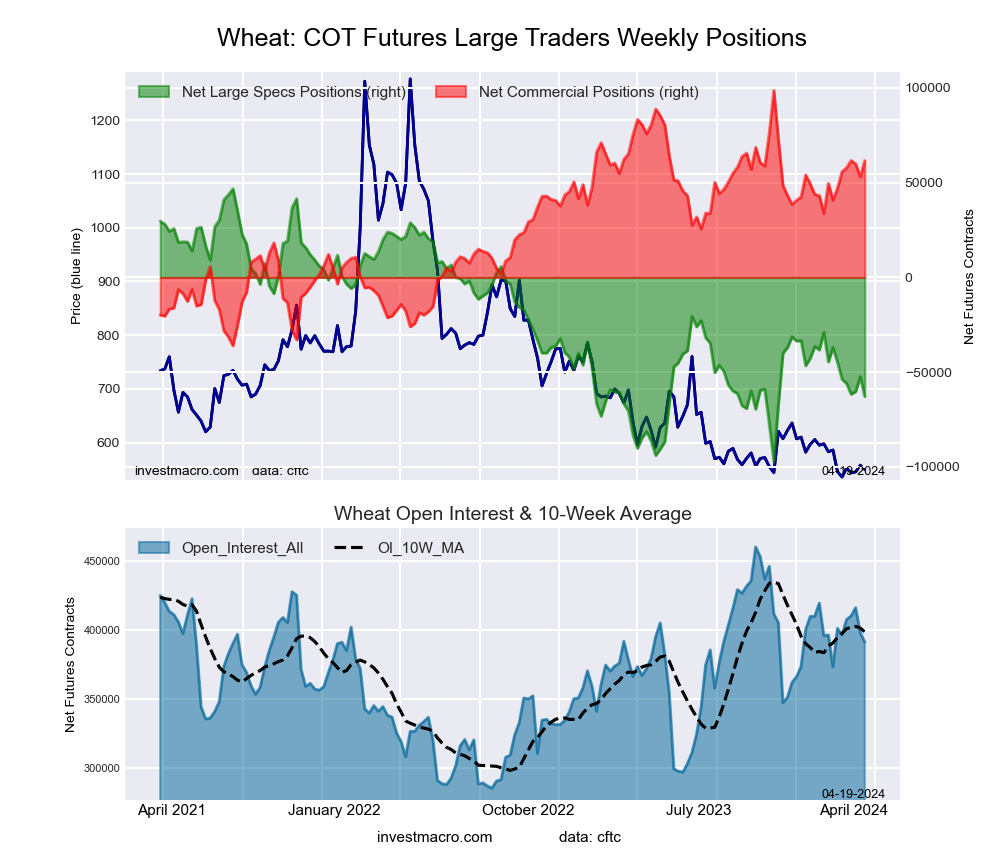 The WHEAT large speculator standing this week came in at a net position of -62,897 contracts in the data reported through Tuesday. This was a weekly decrease of -10,500 contracts from the previous week which had a total of -52,397 net contracts.
The WHEAT large speculator standing this week came in at a net position of -62,897 contracts in the data reported through Tuesday. This was a weekly decrease of -10,500 contracts from the previous week which had a total of -52,397 net contracts.
This week’s current strength score (the trader positioning range over the past three years, measured from 0 to 100) shows the speculators are currently Bearish with a score of 23.8 percent. The commercials are Bullish with a score of 72.5 percent and the small traders (not shown in chart) are Bullish with a score of 71.8 percent.
Price Trend-Following Model: Strong Downtrend
Our weekly trend-following model classifies the current market price position as: Strong Downtrend. The current action for the model is considered to be: Hold – Maintain Short Position.
| WHEAT Futures Statistics | SPECULATORS | COMMERCIALS | SMALL TRADERS |
| – Percent of Open Interest Longs: | 30.4 | 36.0 | 8.1 |
| – Percent of Open Interest Shorts: | 46.4 | 20.3 | 7.8 |
| – Net Position: | -62,897 | 61,586 | 1,311 |
| – Gross Longs: | 118,774 | 141,027 | 31,794 |
| – Gross Shorts: | 181,671 | 79,441 | 30,483 |
| – Long to Short Ratio: | 0.7 to 1 | 1.8 to 1 | 1.0 to 1 |
| NET POSITION TREND: | | | |
| – Strength Index Score (3 Year Range Pct): | 23.8 | 72.5 | 71.8 |
| – Strength Index Reading (3 Year Range): | Bearish | Bullish | Bullish |
| NET POSITION MOVEMENT INDEX: | | | |
| – 6-Week Change in Strength Index: | -12.6 | 10.7 | 16.0 |
Article By InvestMacro – Receive our weekly COT Newsletter
*COT Report: The COT data, released weekly to the public each Friday, is updated through the most recent Tuesday (data is 3 days old) and shows a quick view of how large speculators or non-commercials (for-profit traders) were positioned in the futures markets.
The CFTC categorizes trader positions according to commercial hedgers (traders who use futures contracts for hedging as part of the business), non-commercials (large traders who speculate to realize trading profits) and nonreportable traders (usually small traders/speculators) as well as their open interest (contracts open in the market at time of reporting). See CFTC criteria here.

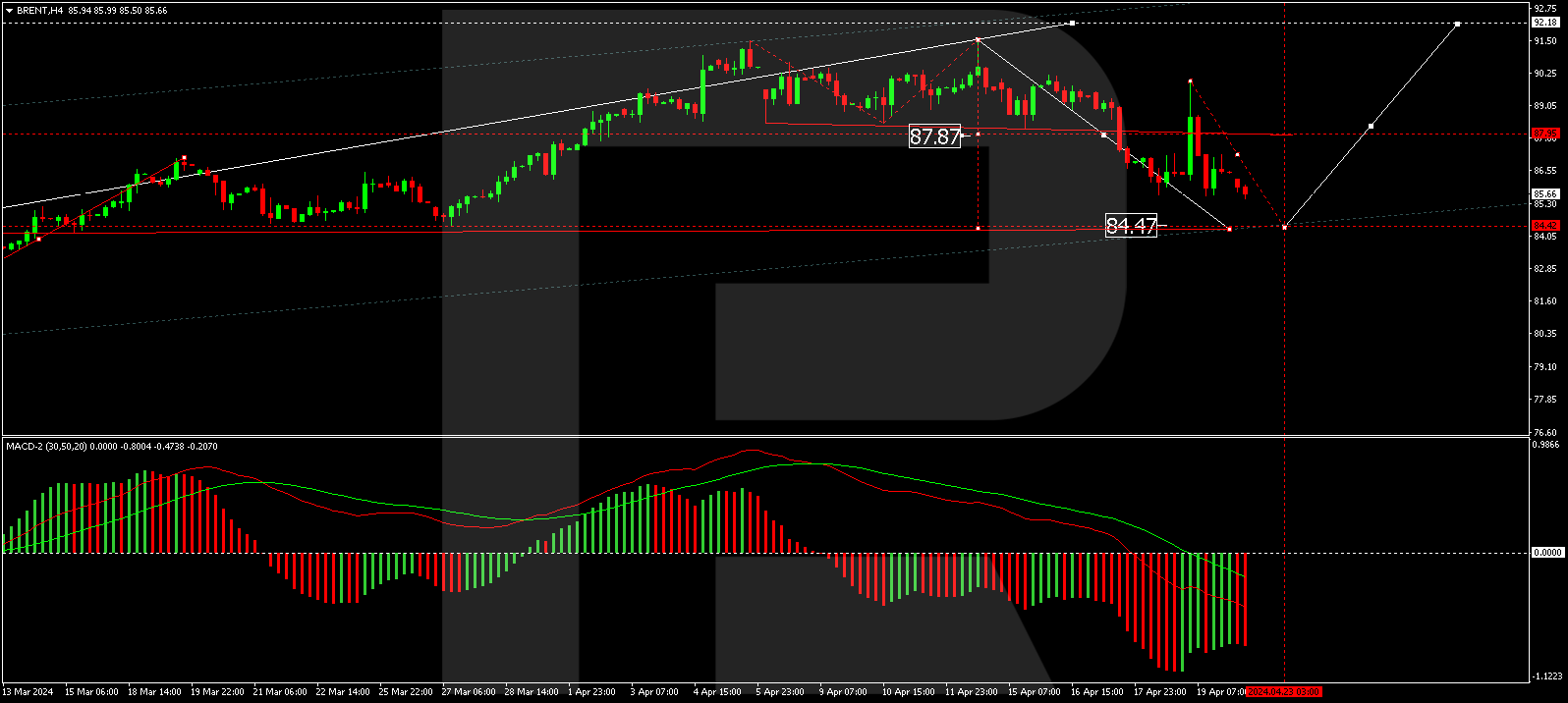
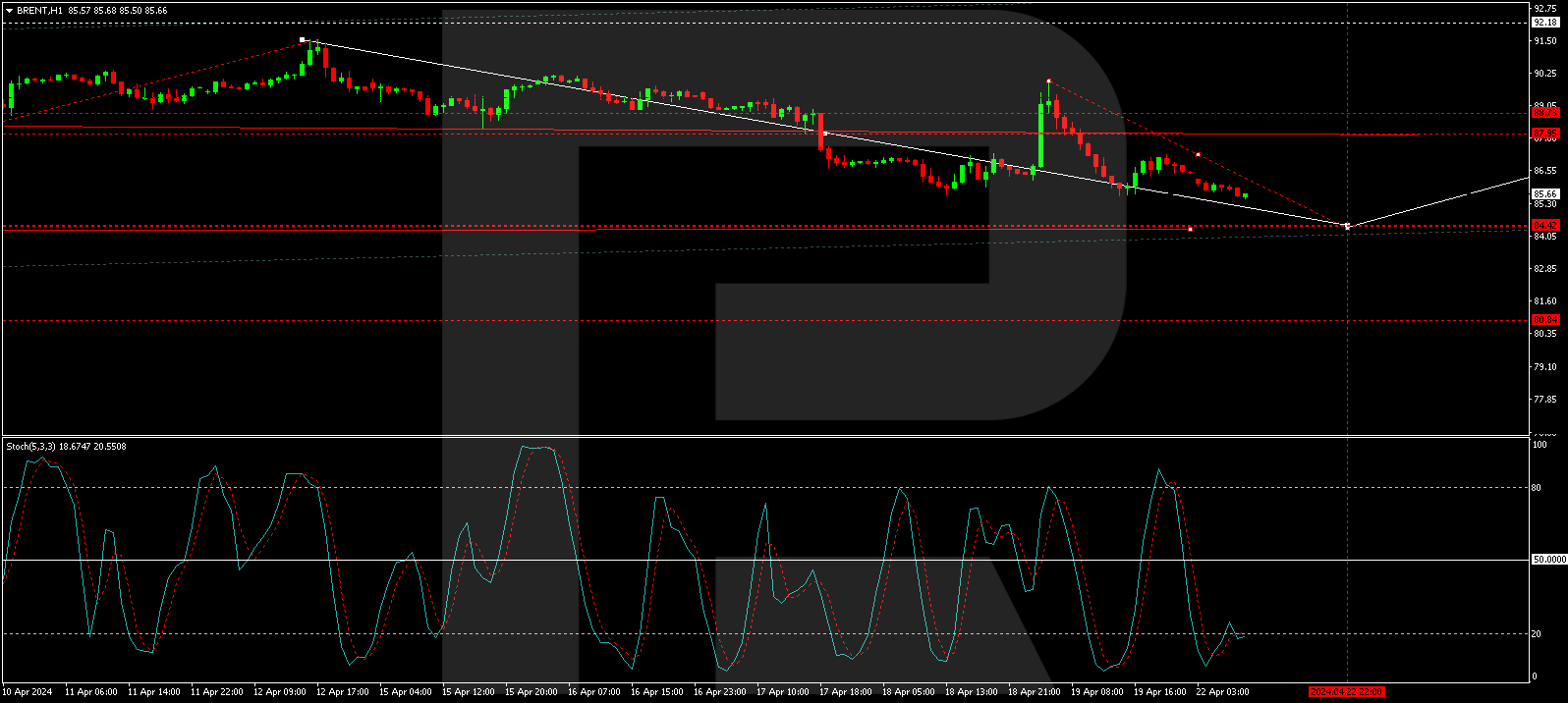

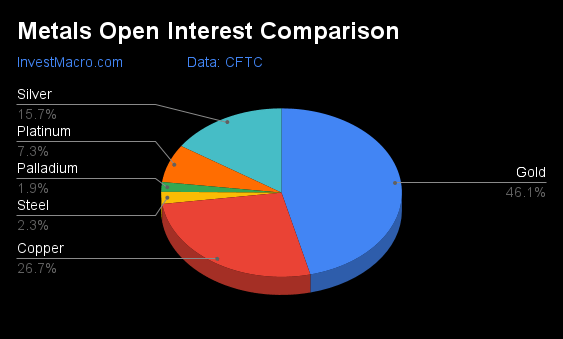
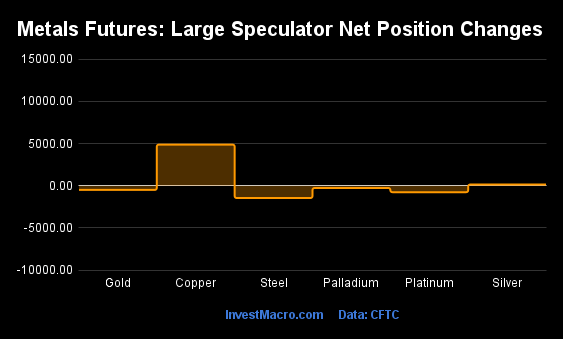


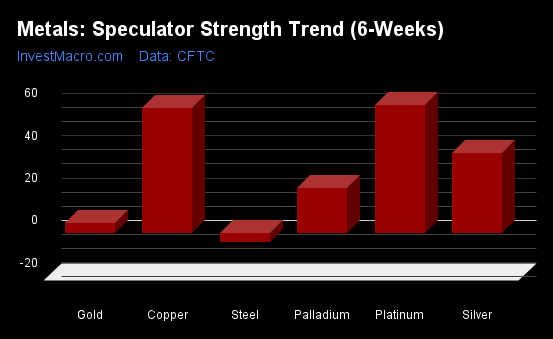
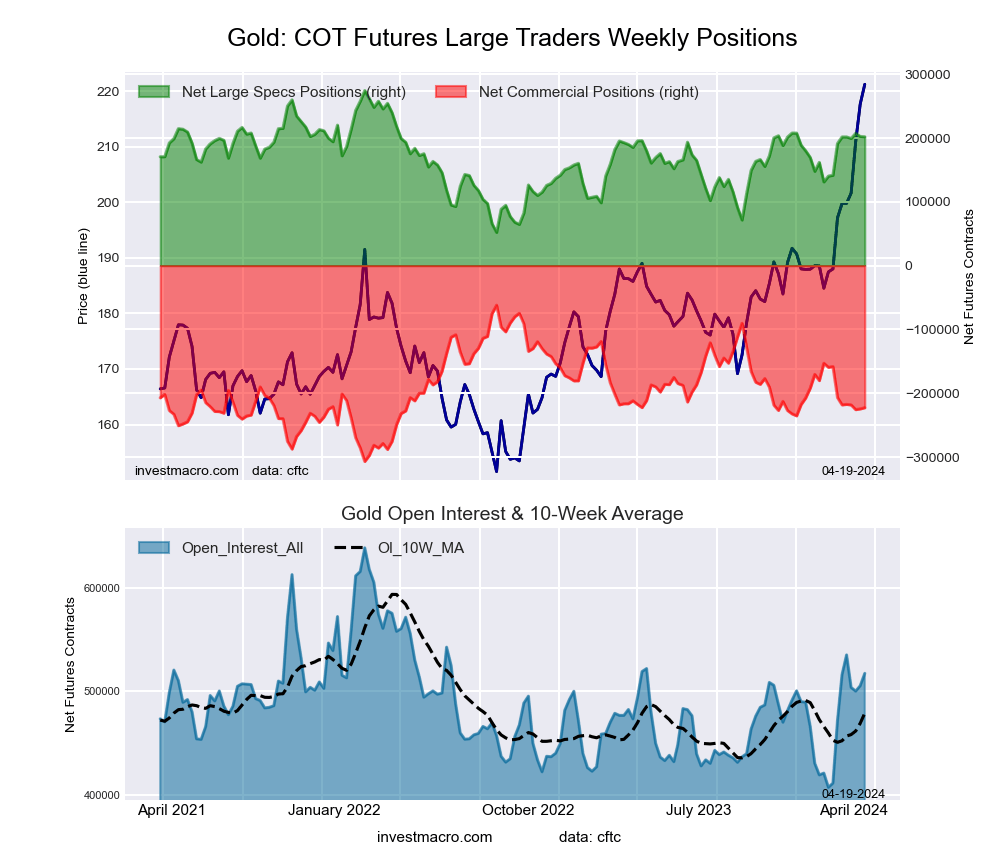
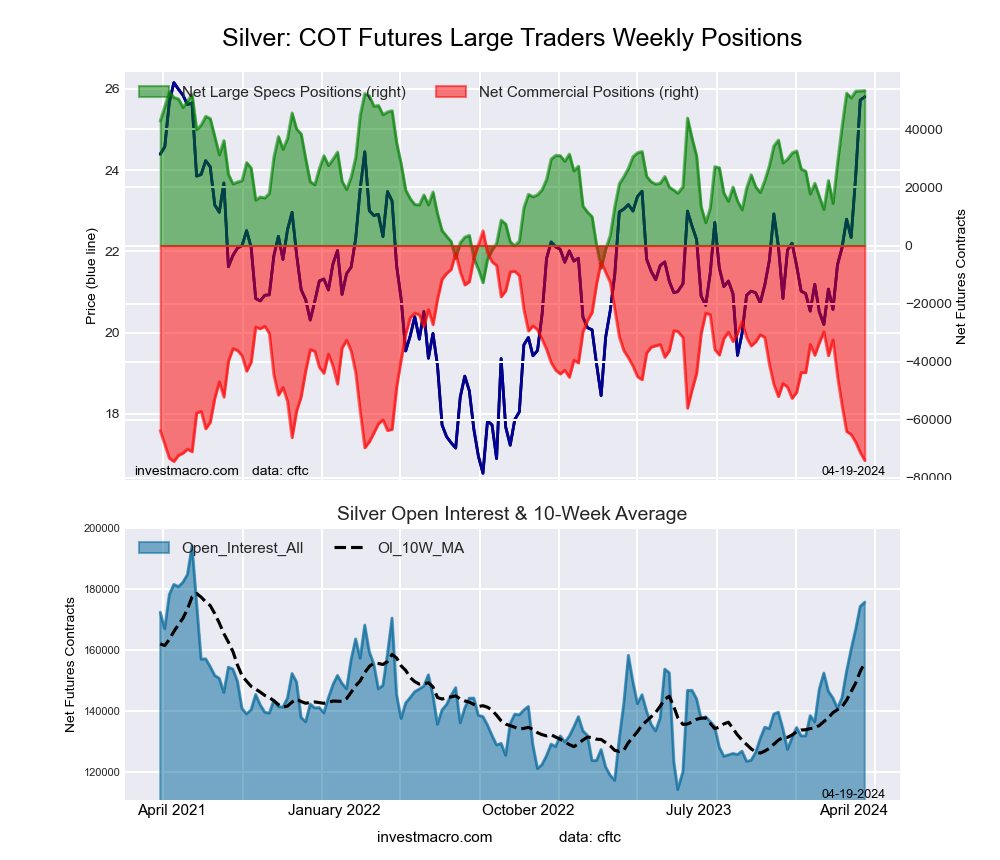
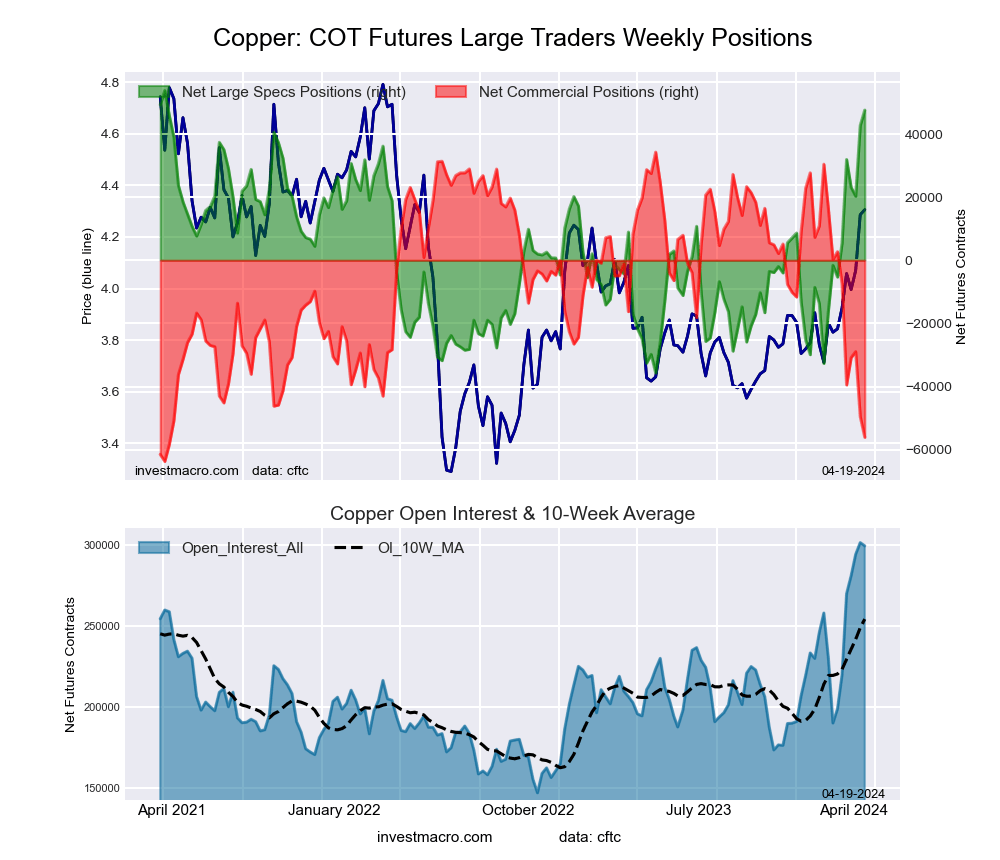
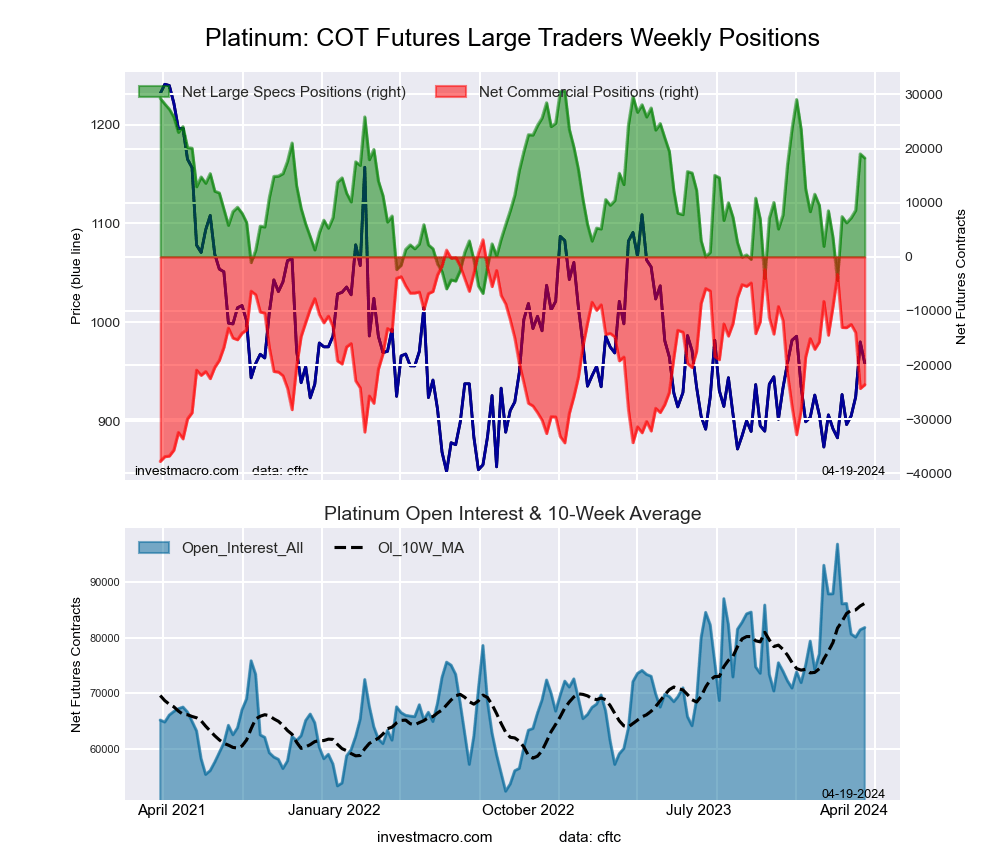
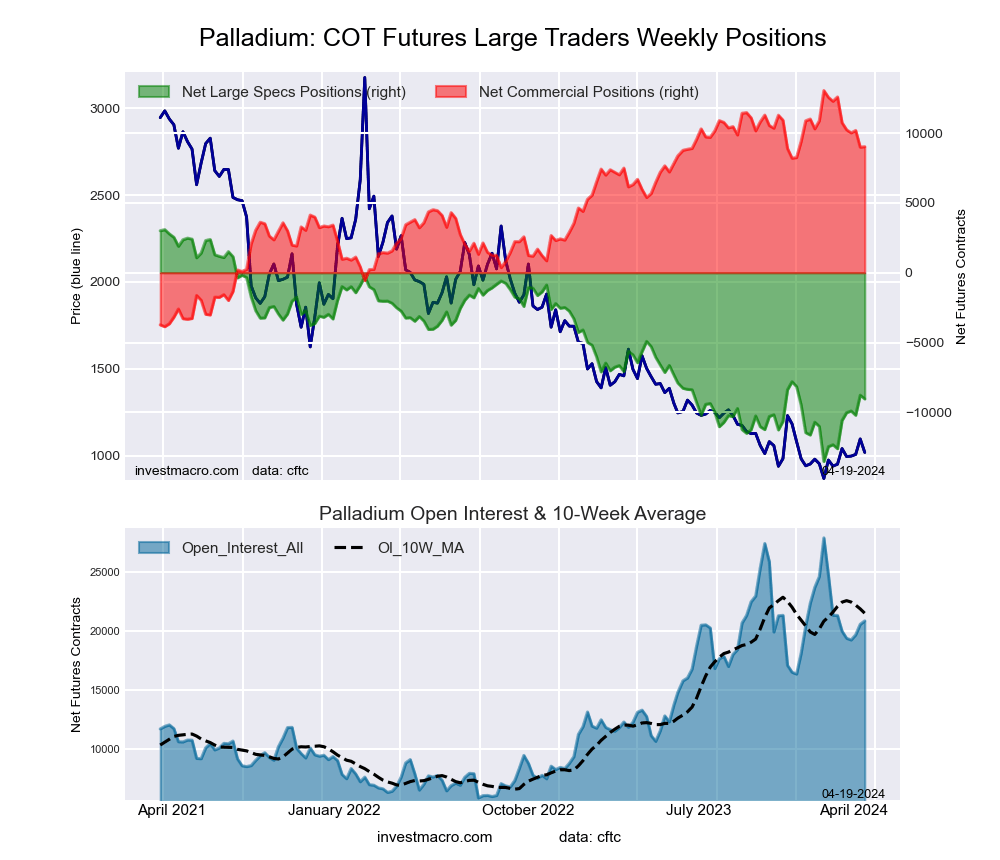
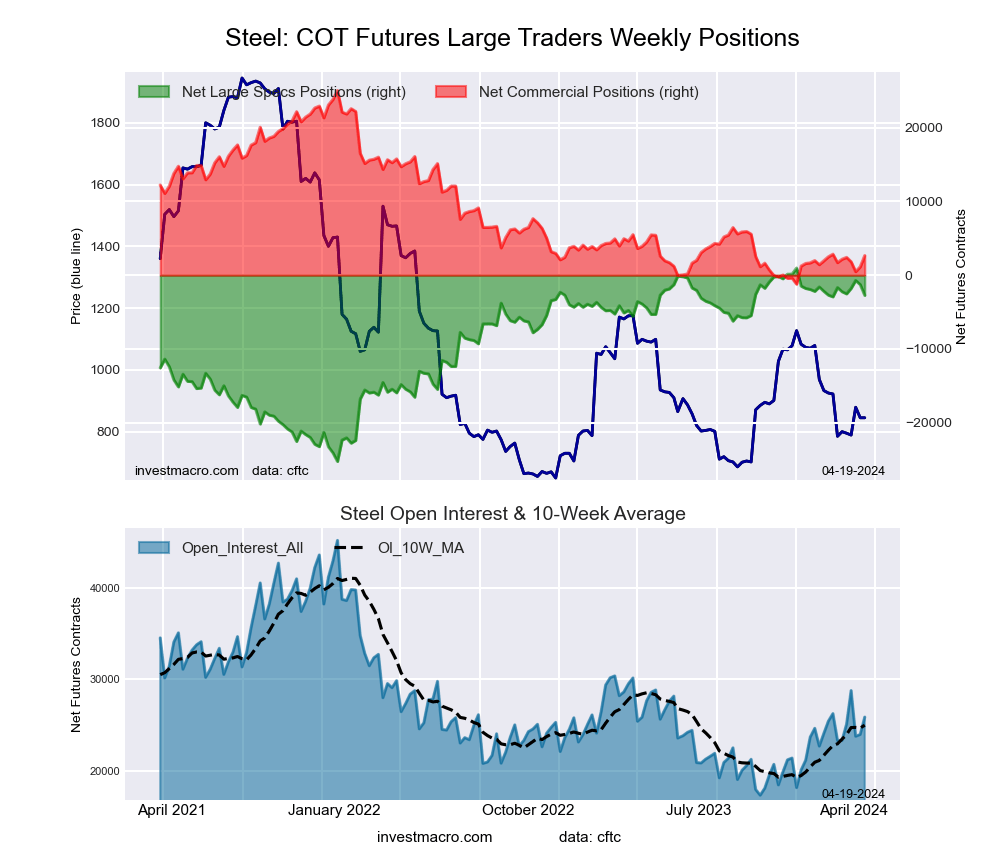

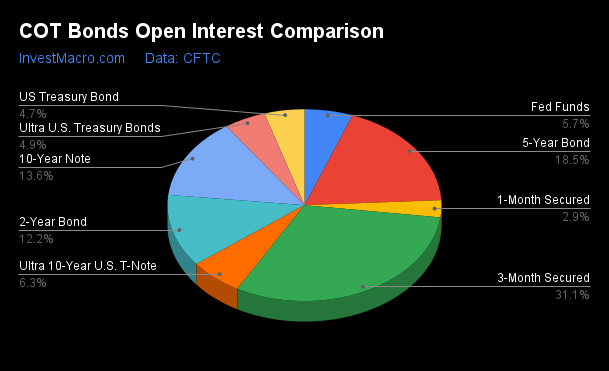
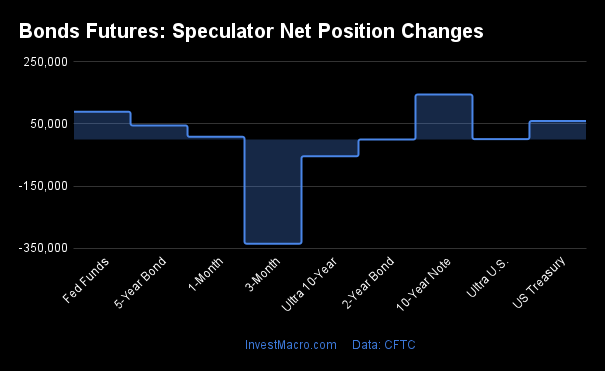
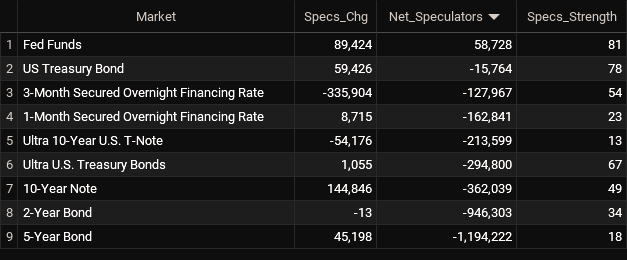
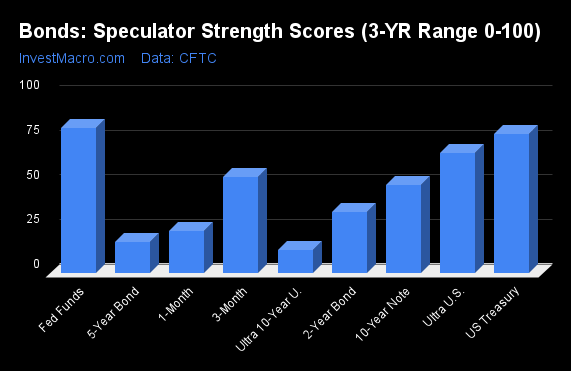
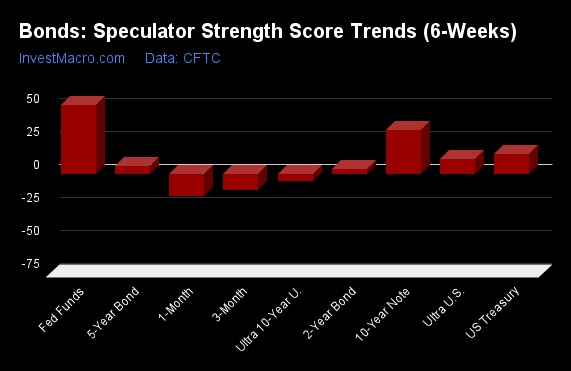
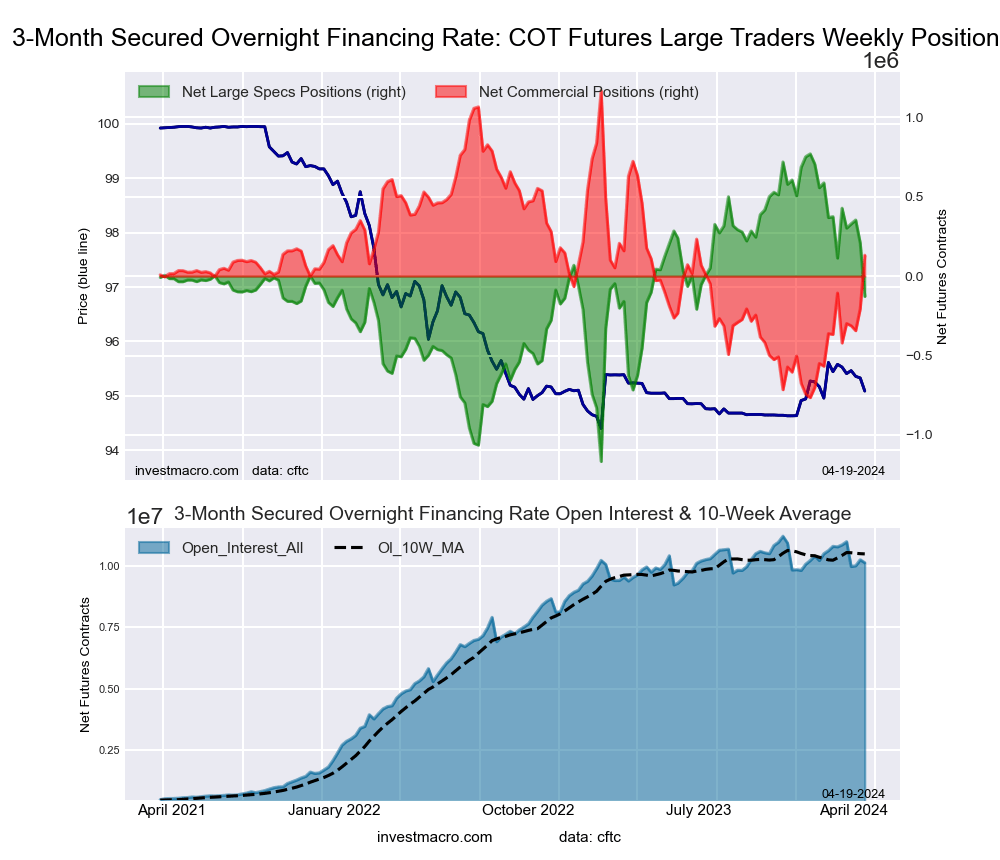
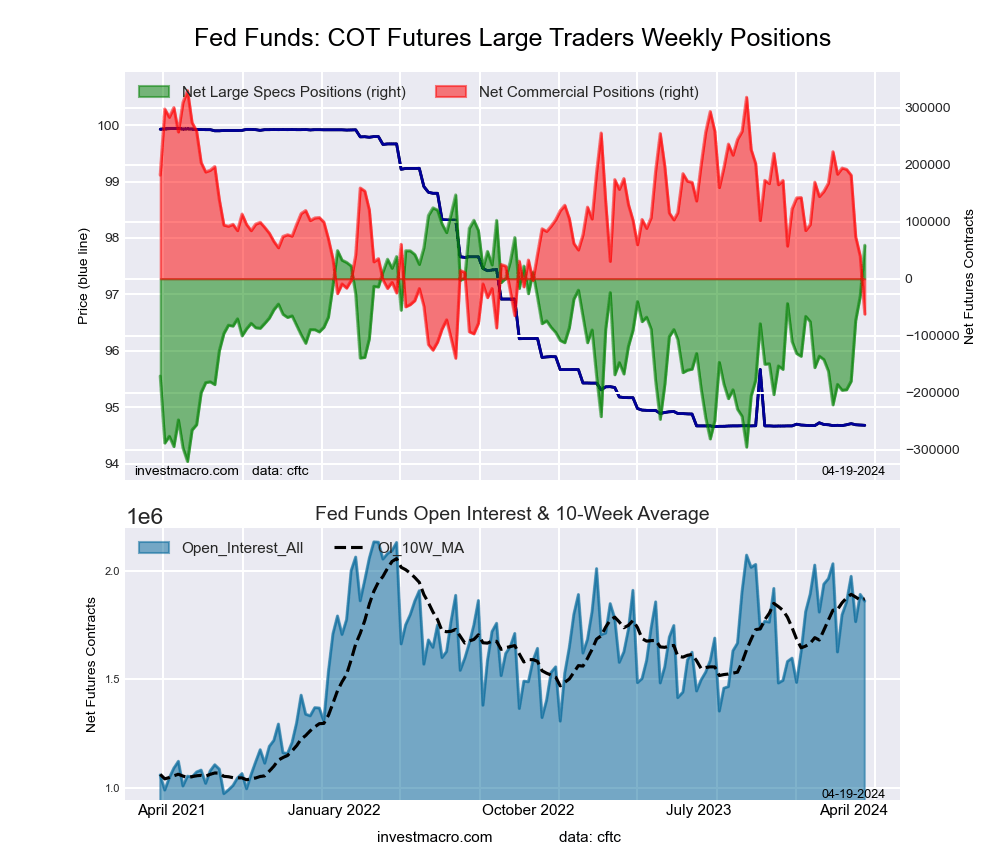

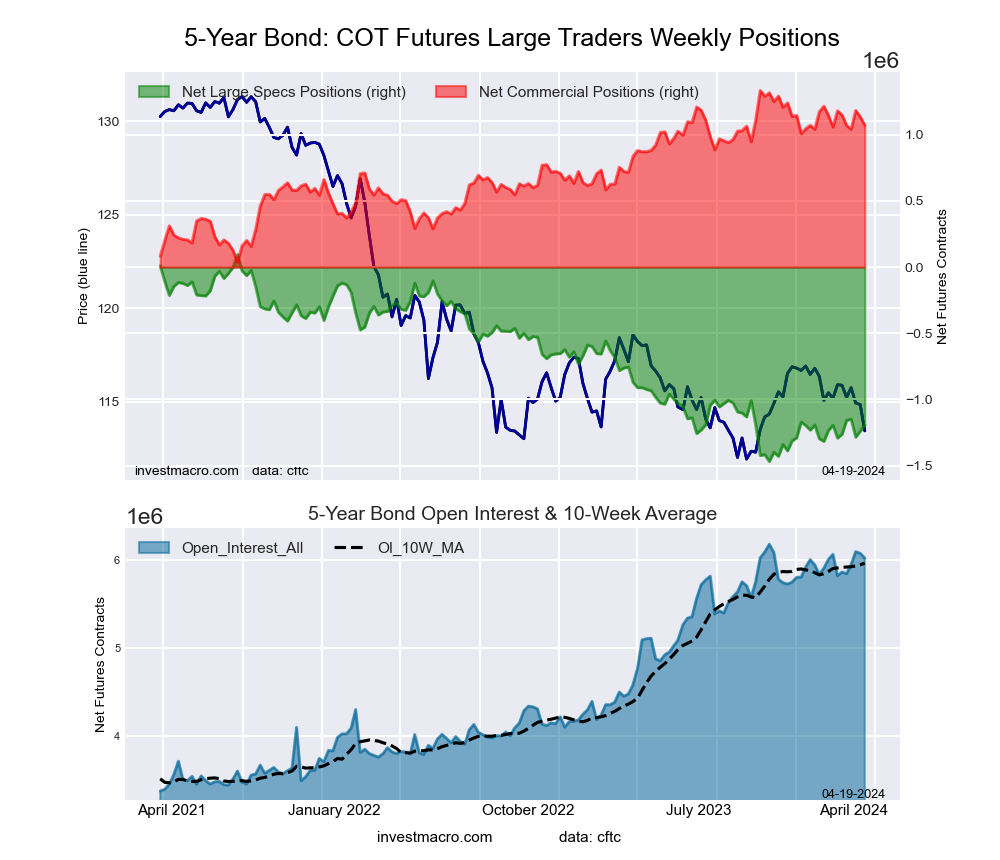
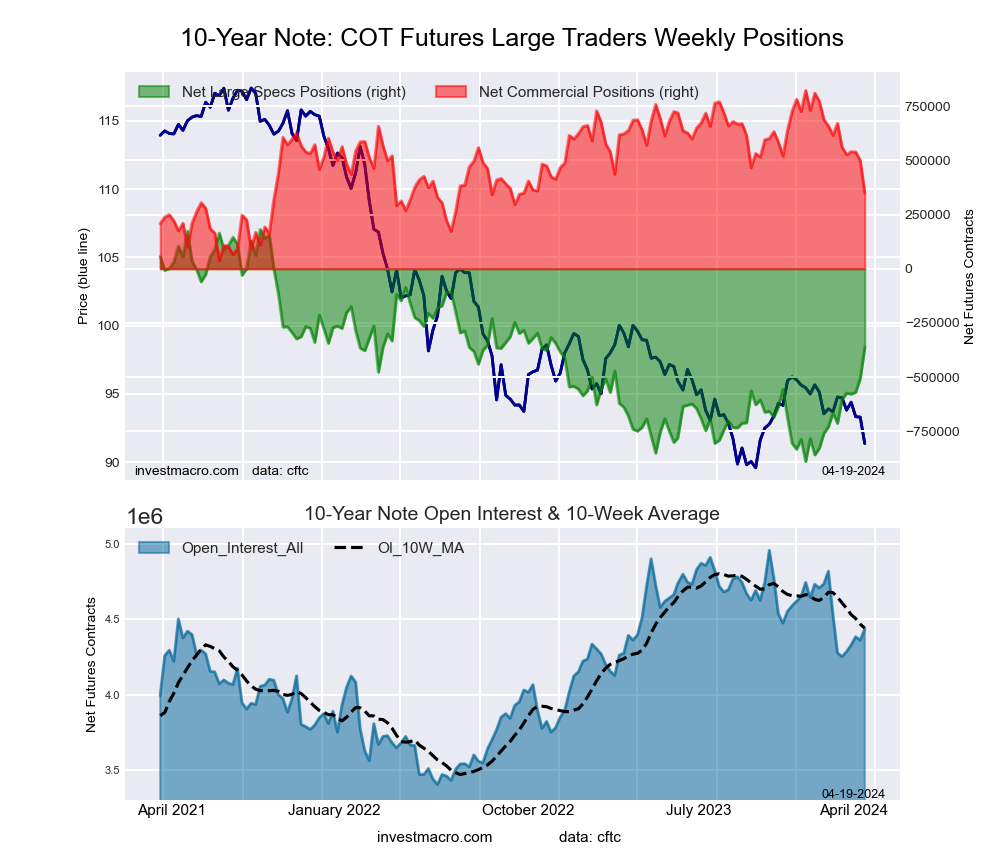
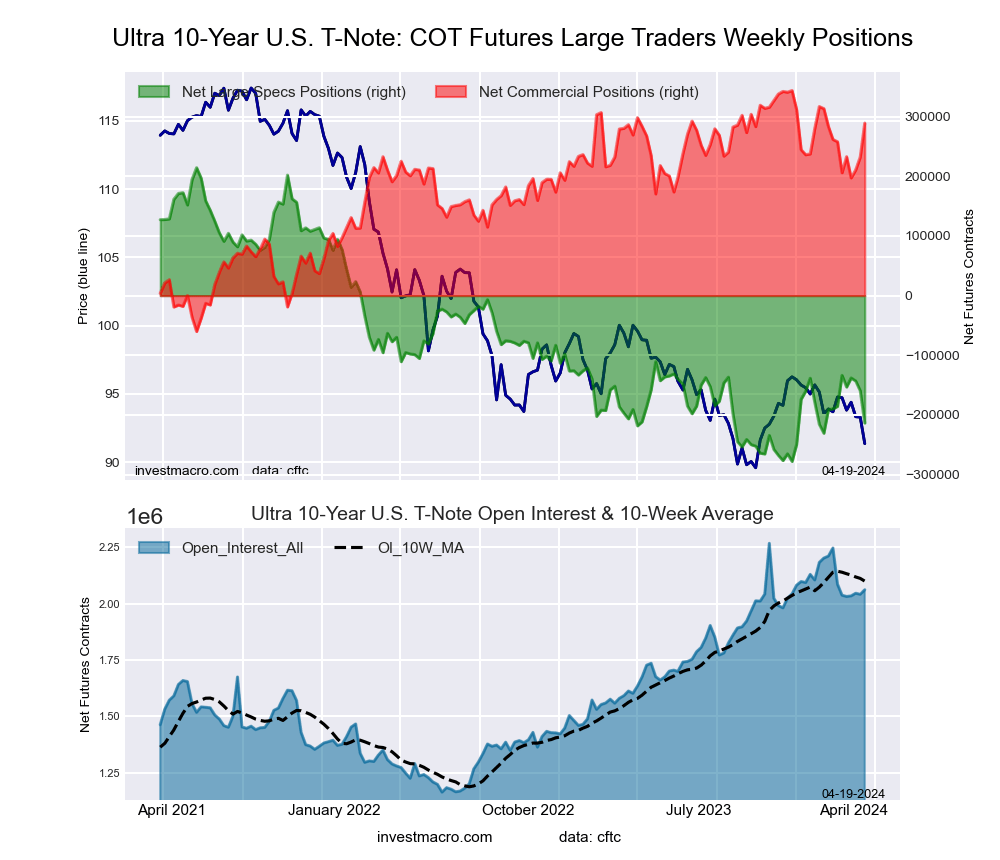
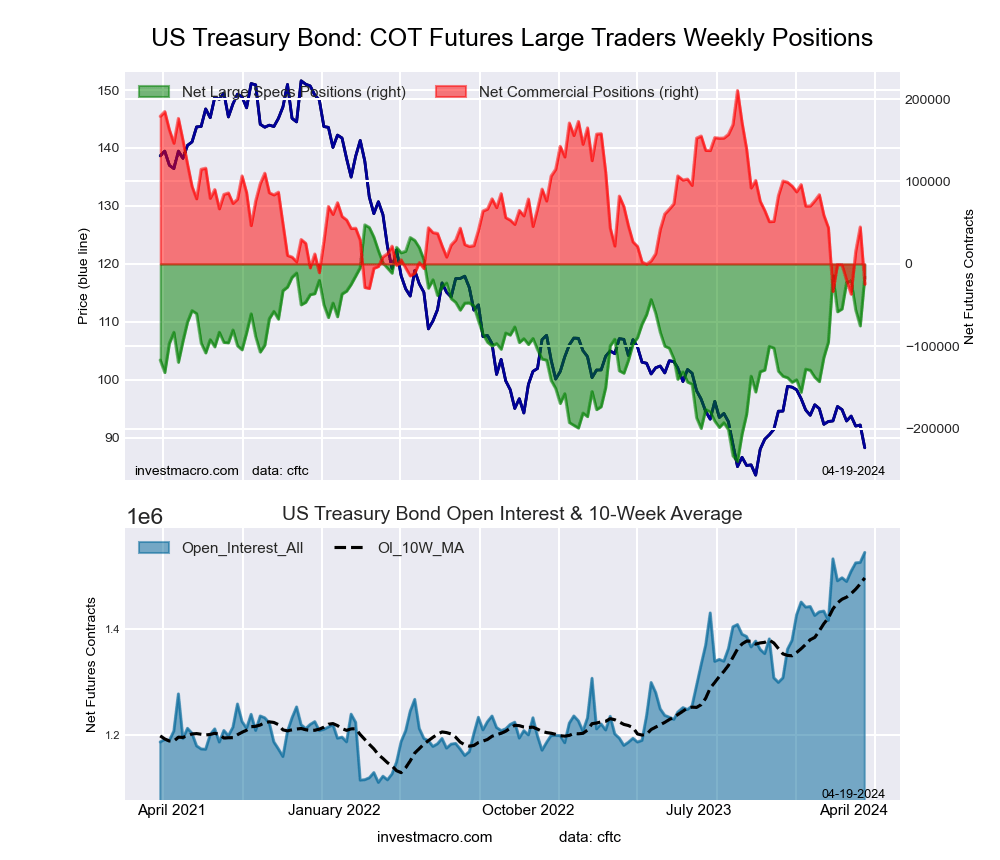
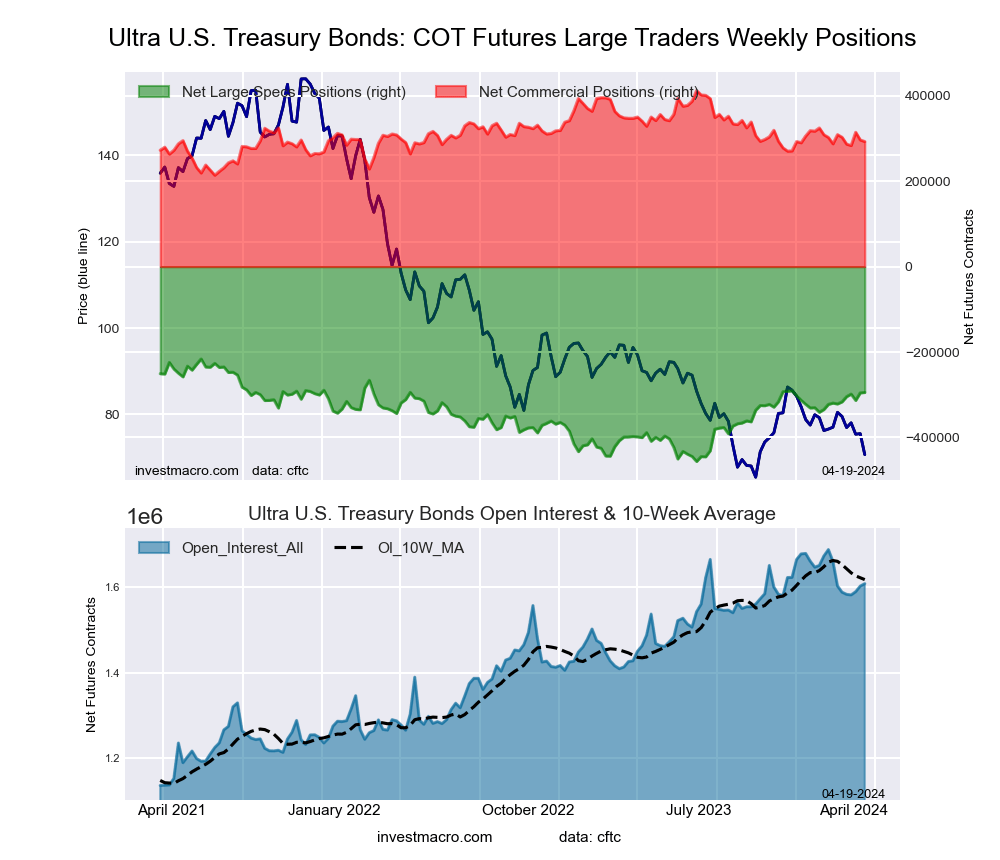

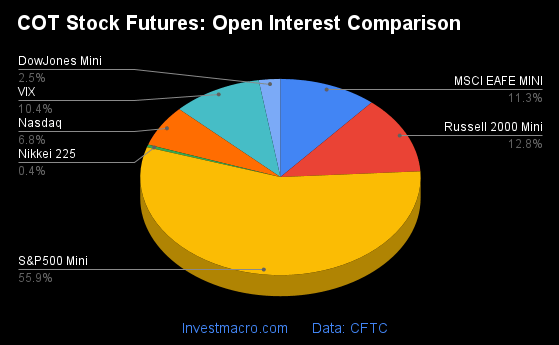
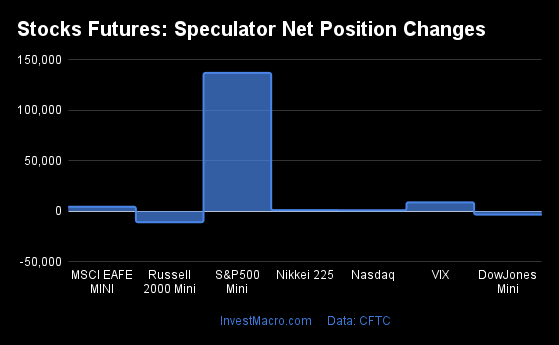


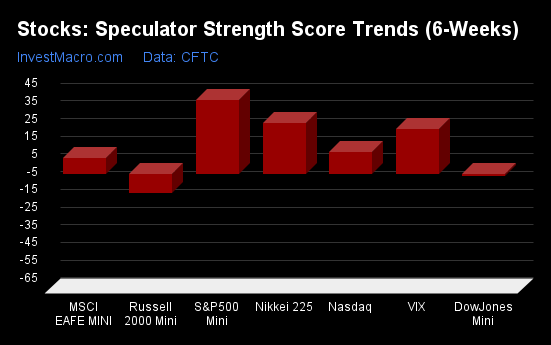
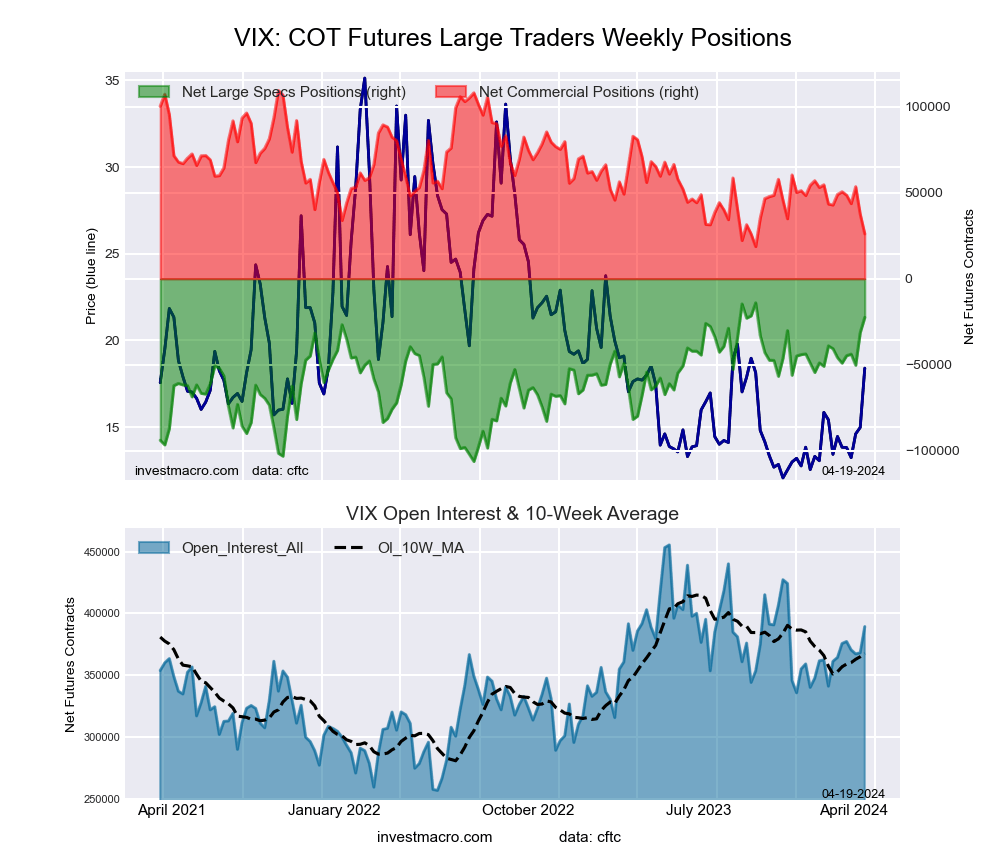
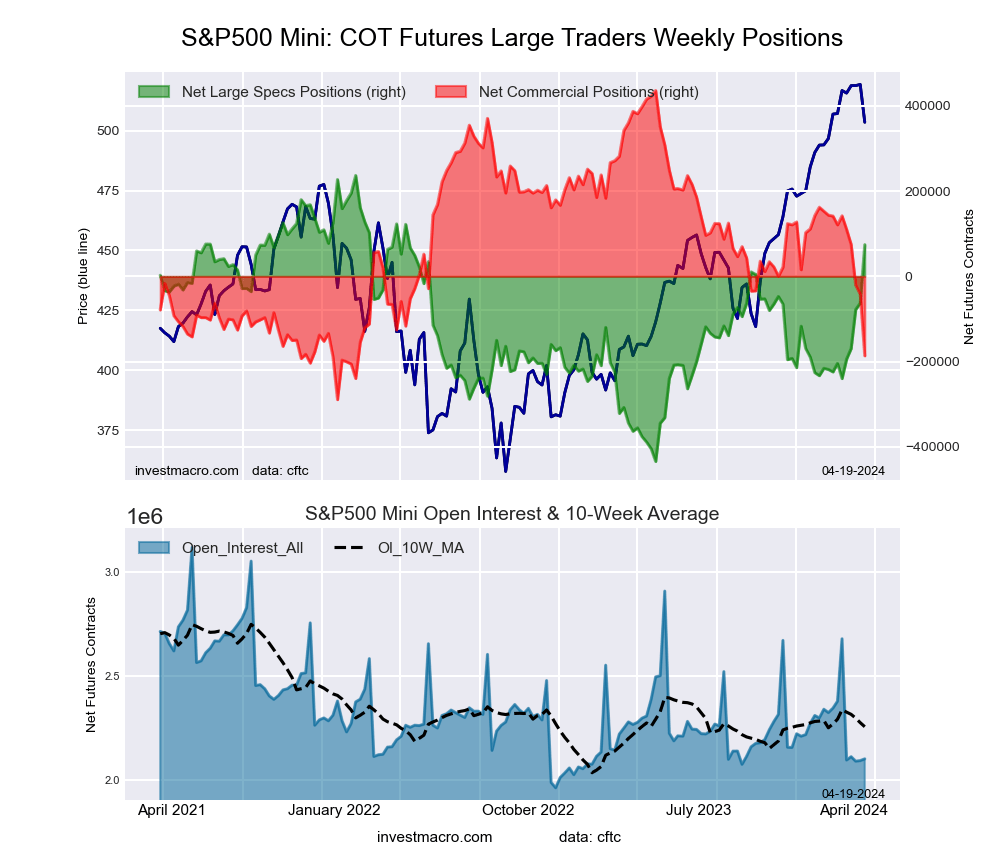
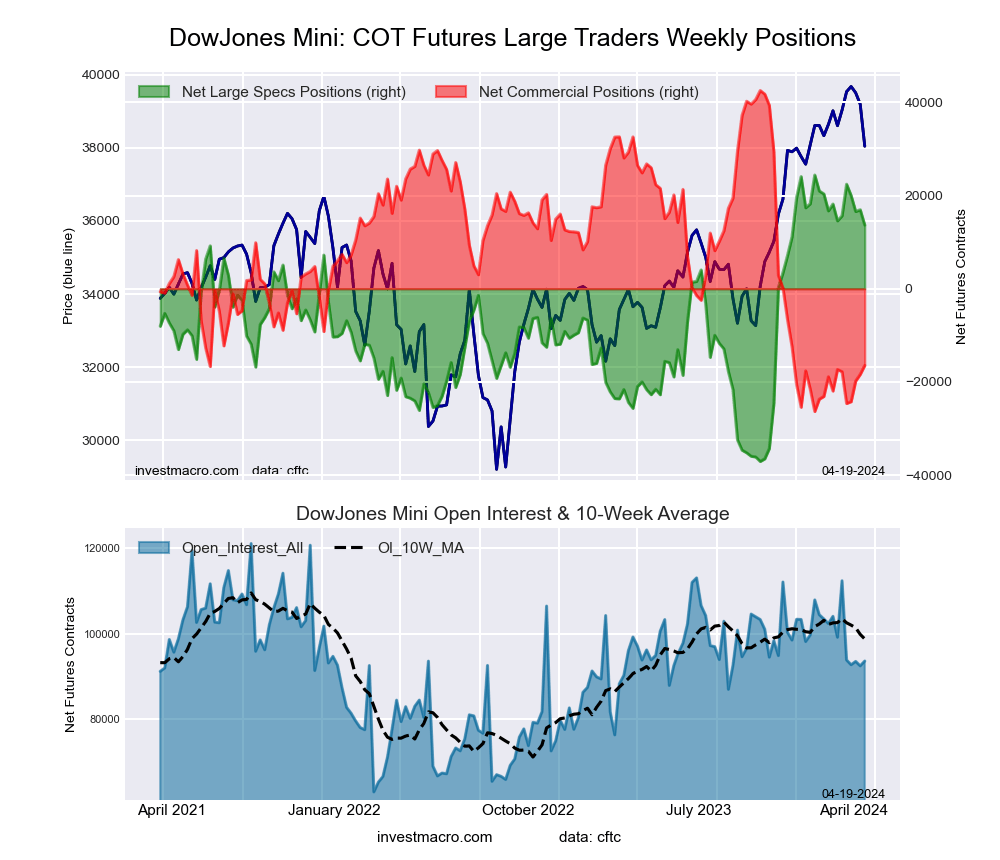
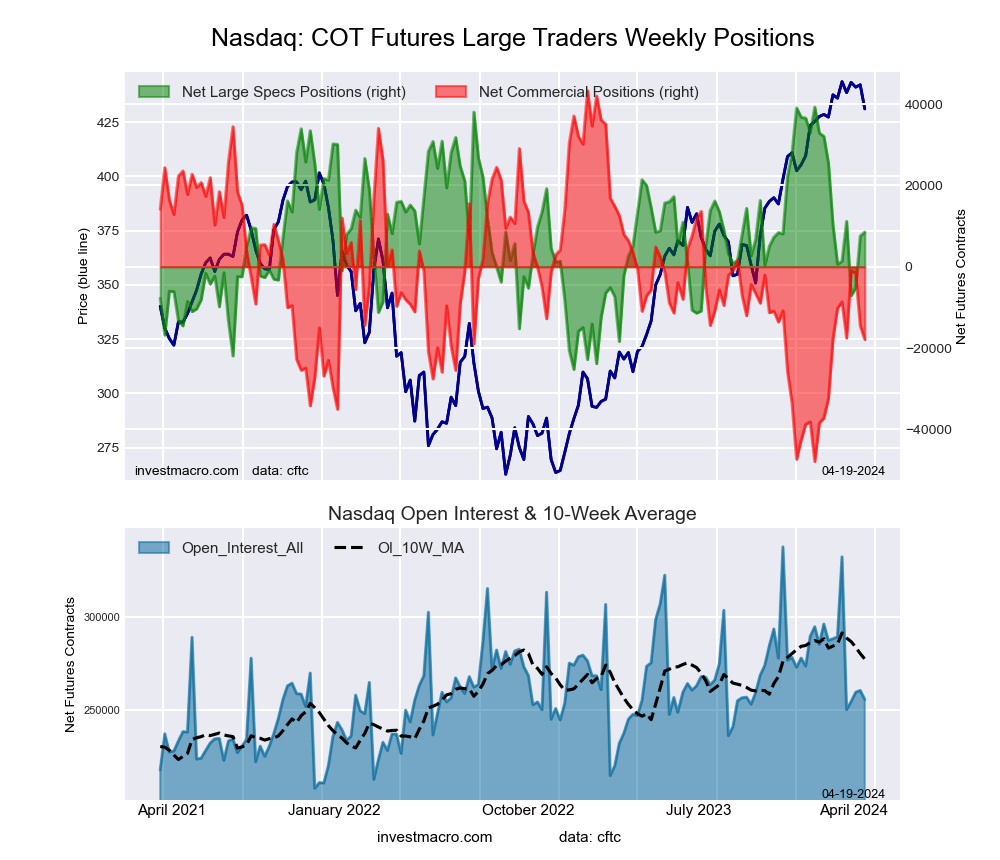

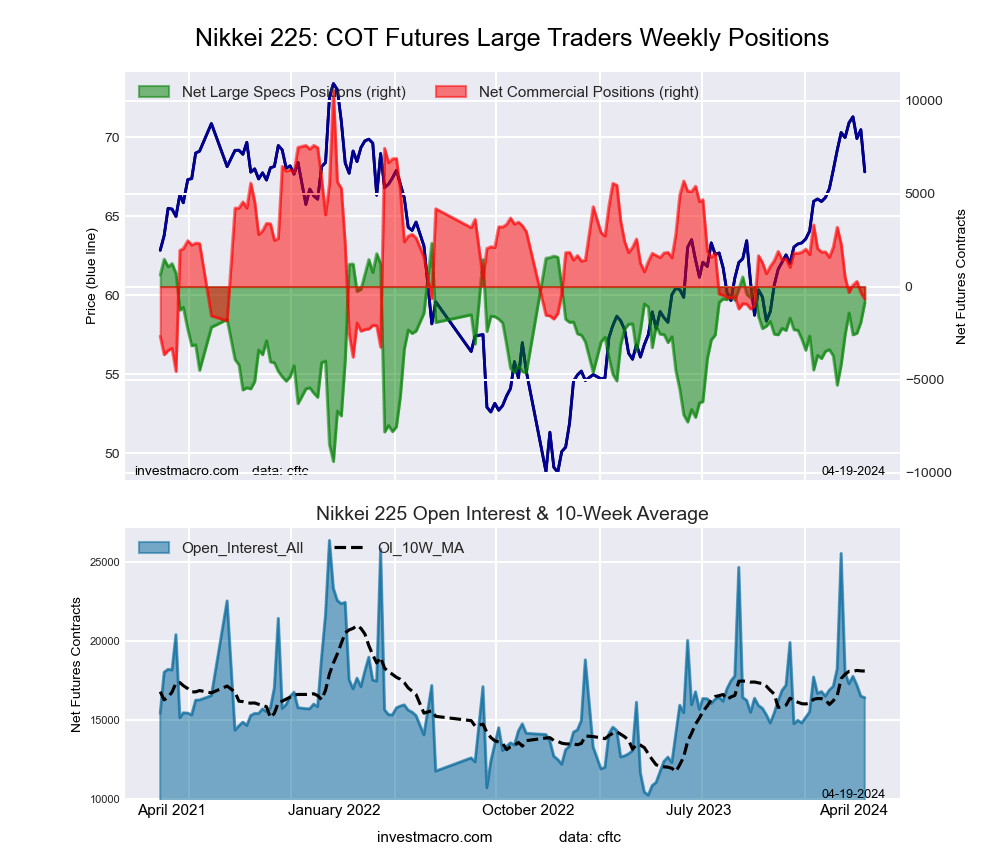
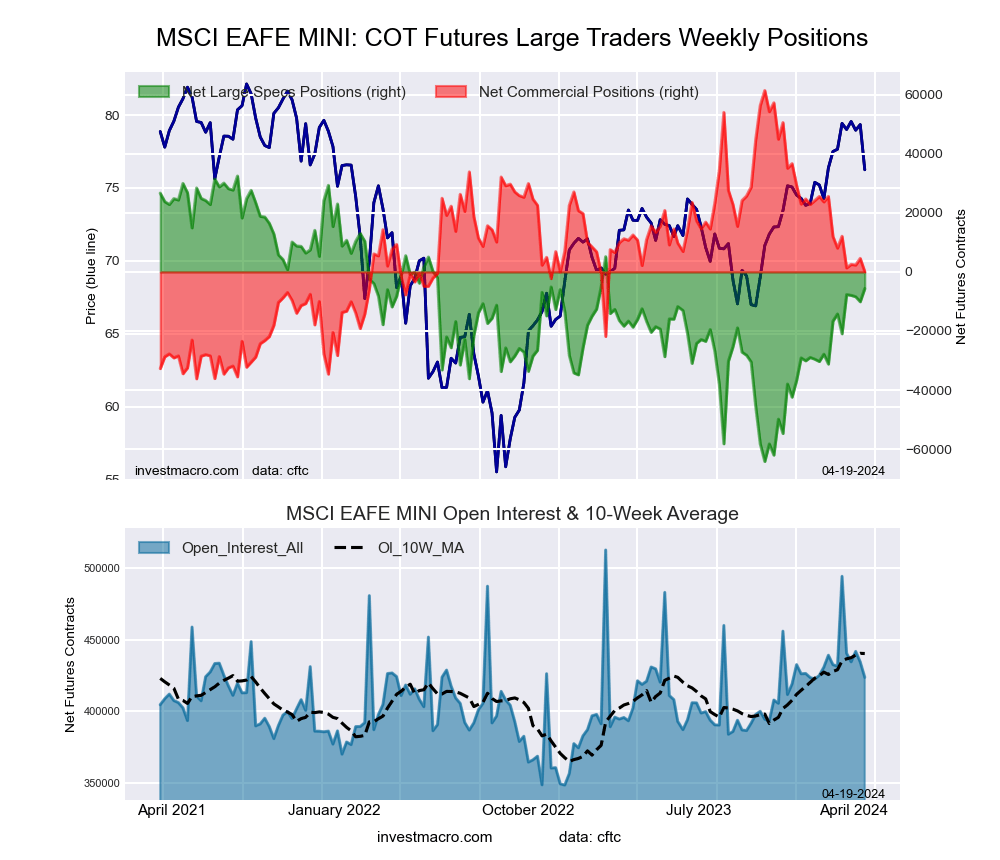






















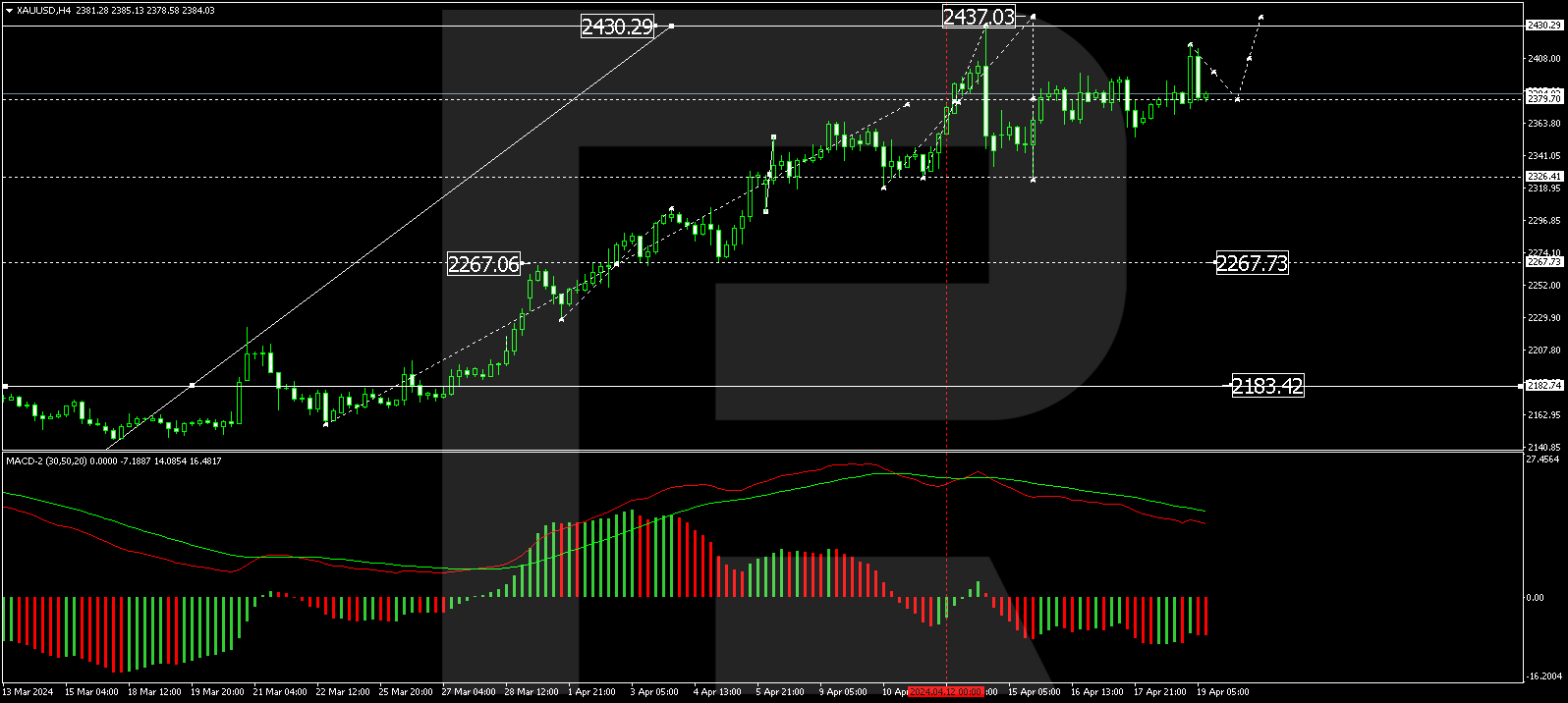
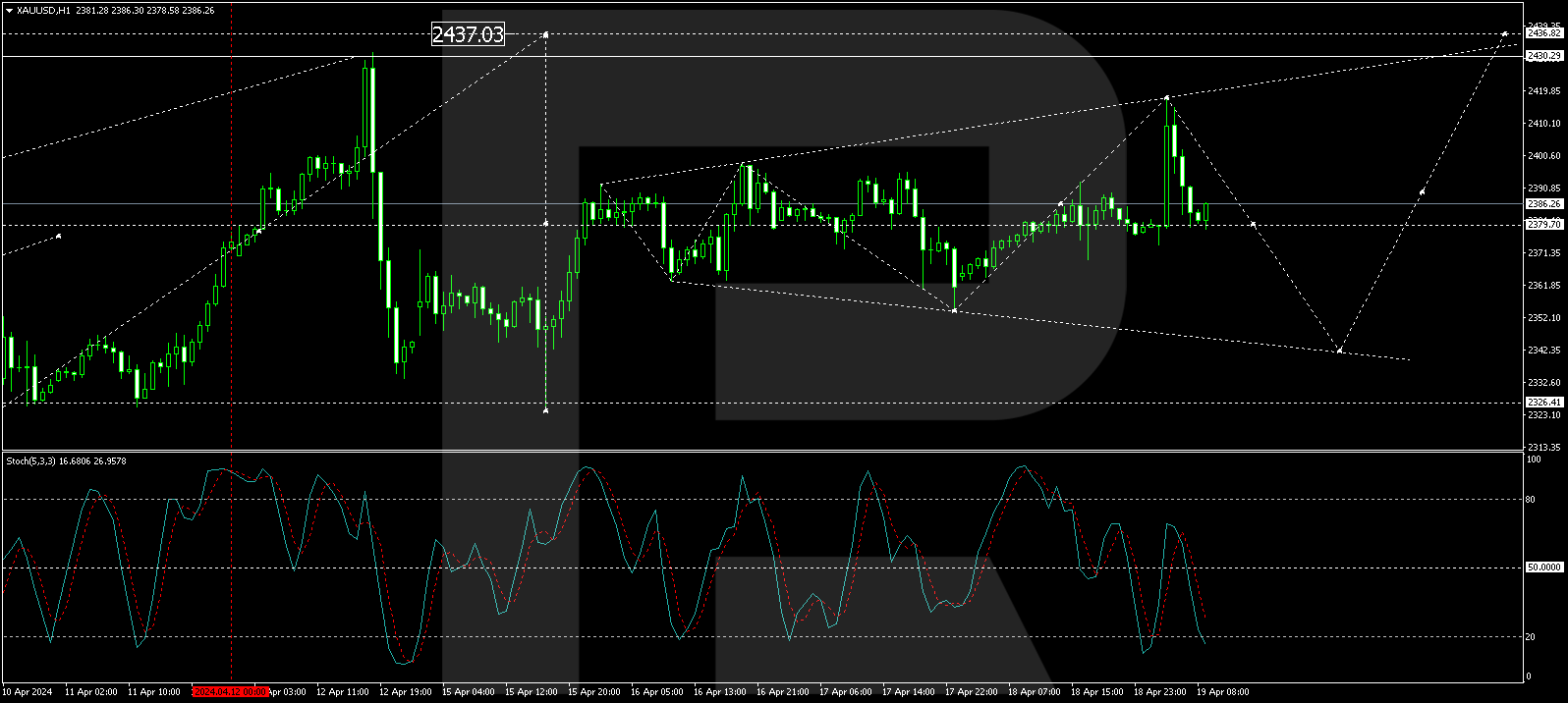




 Article by
Article by